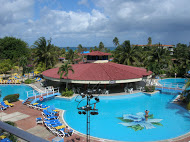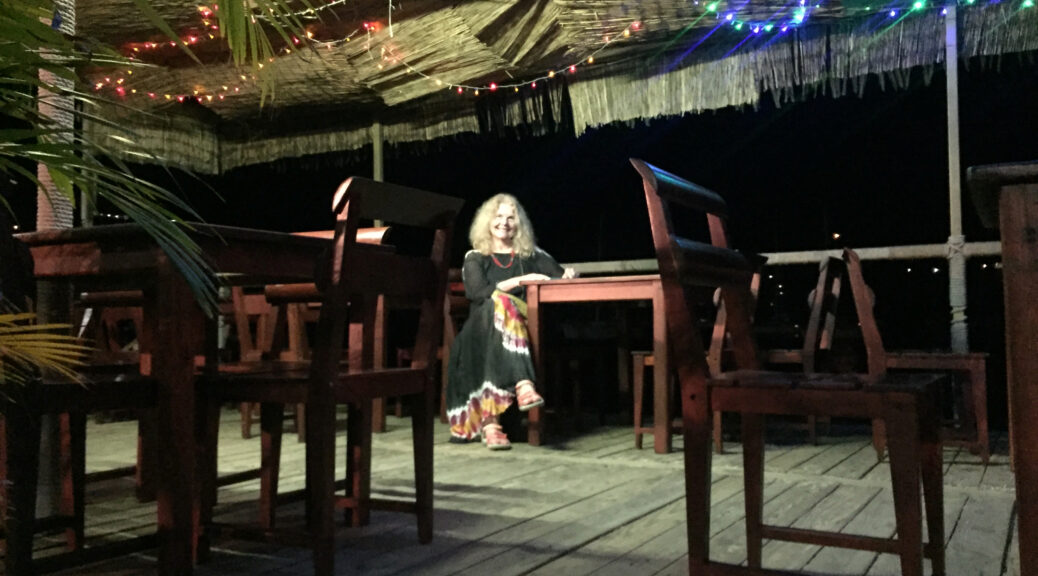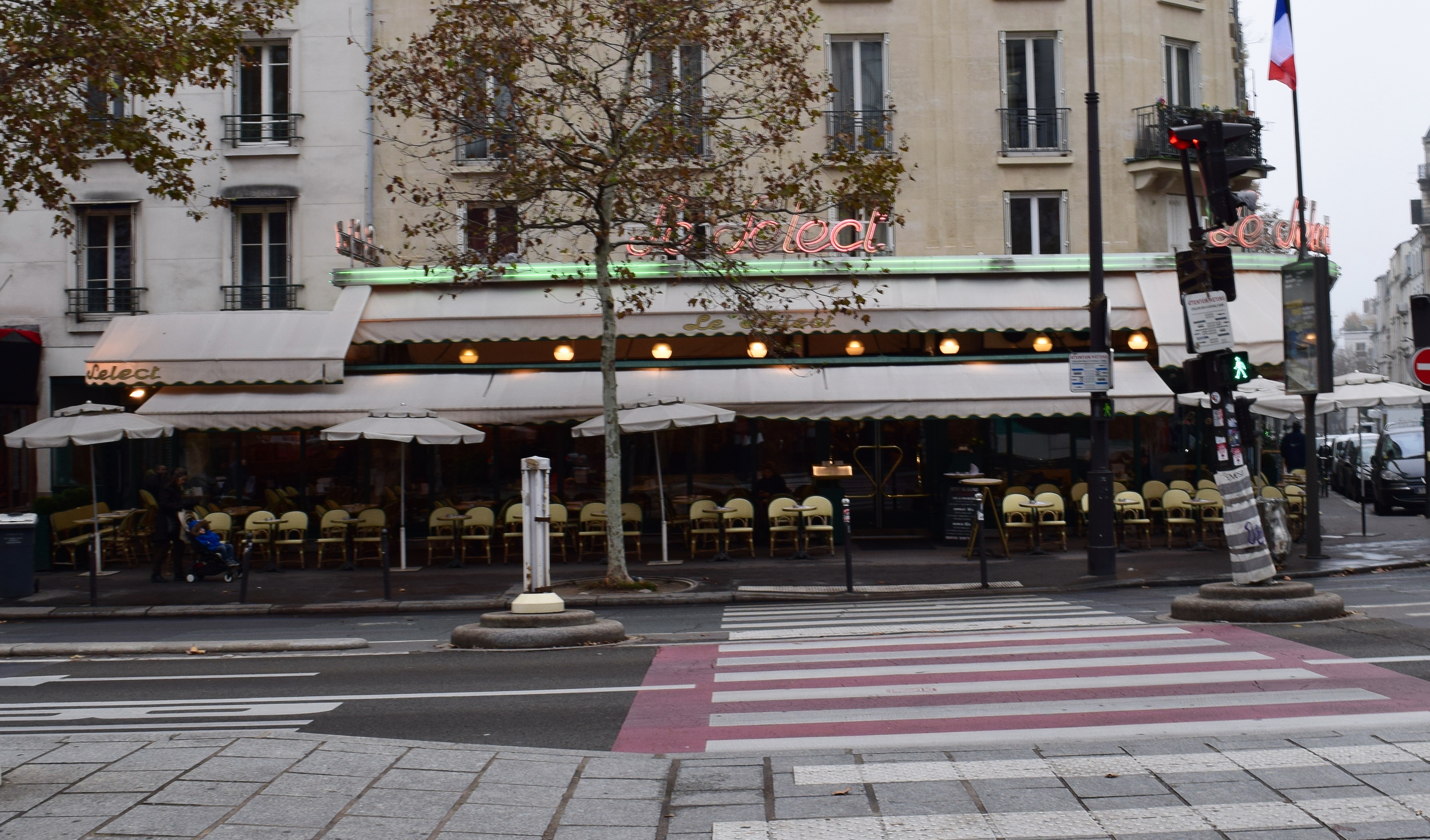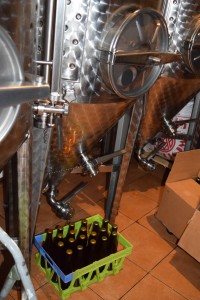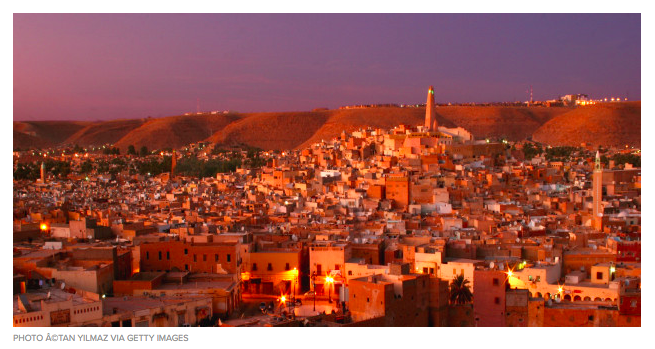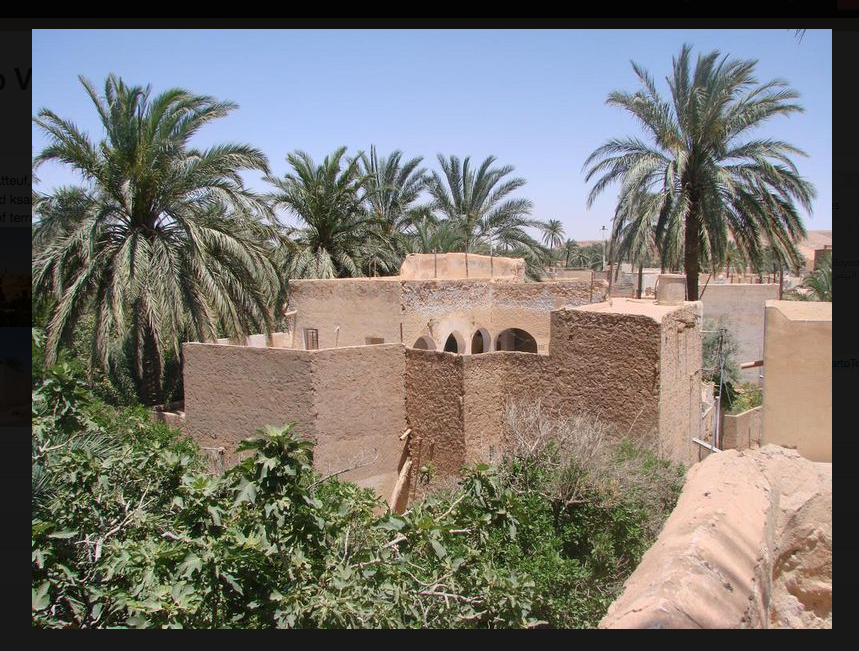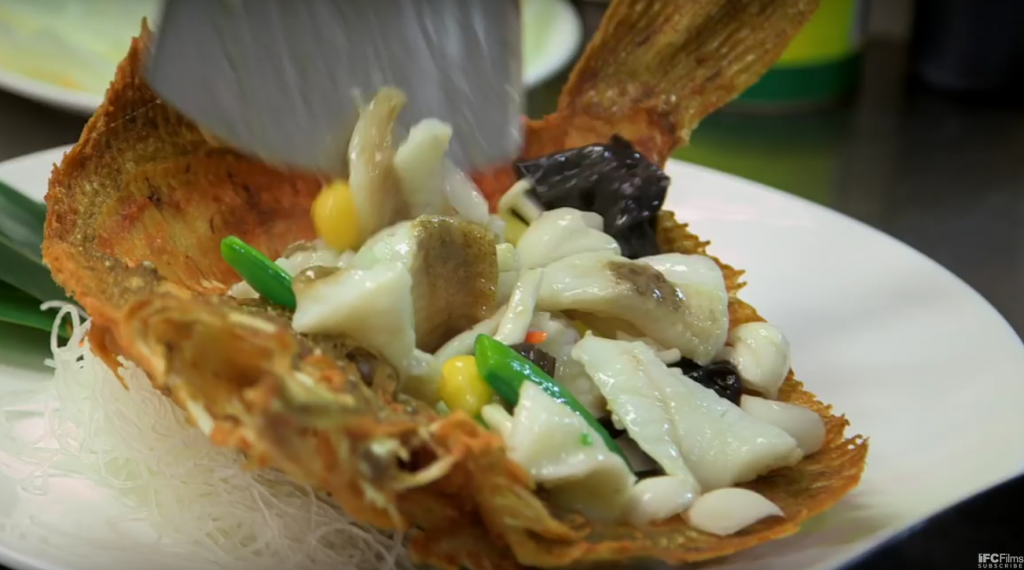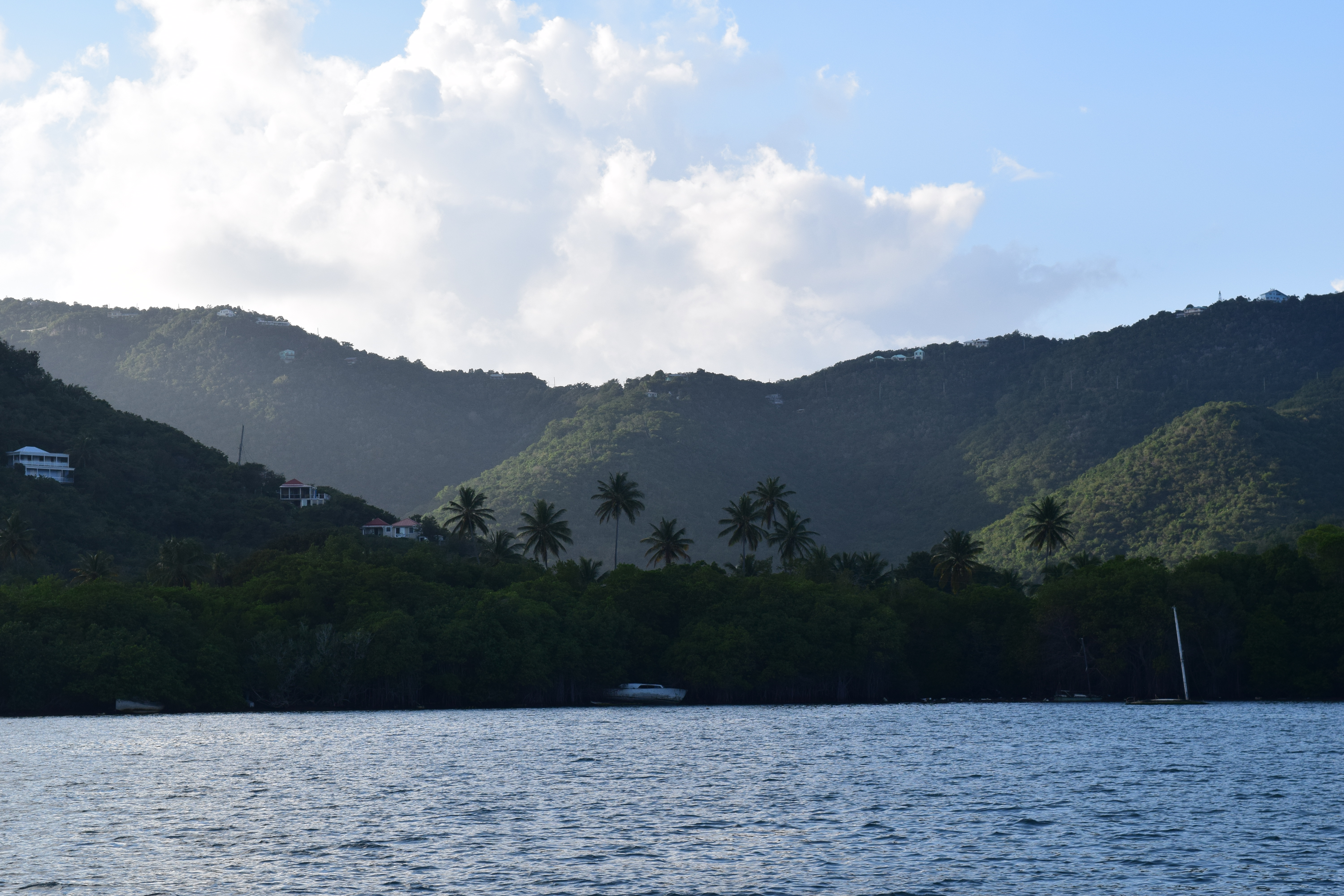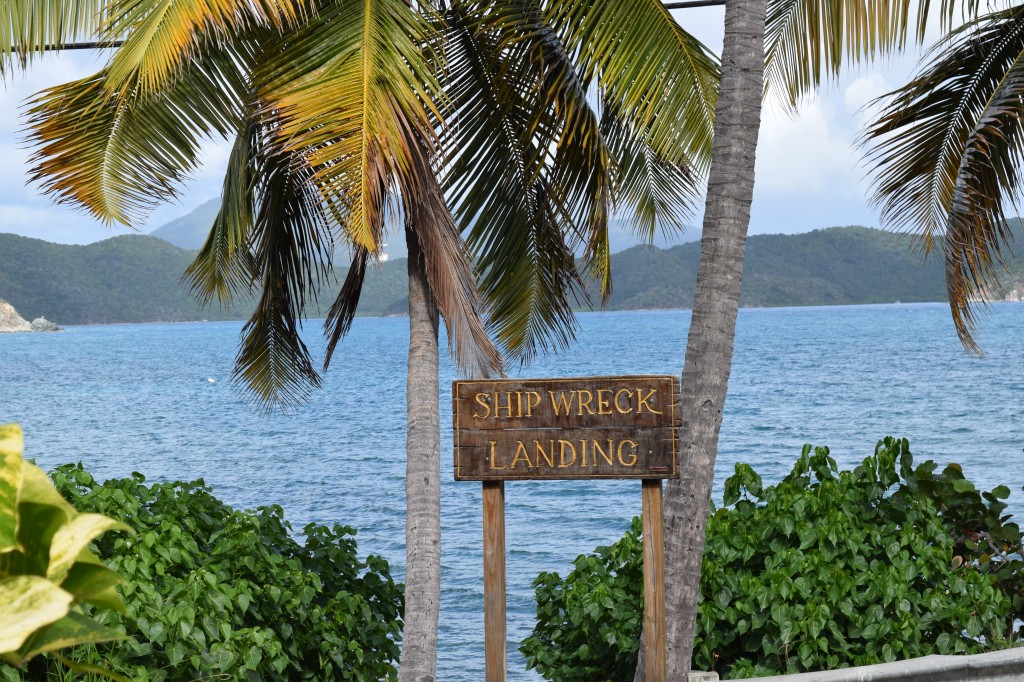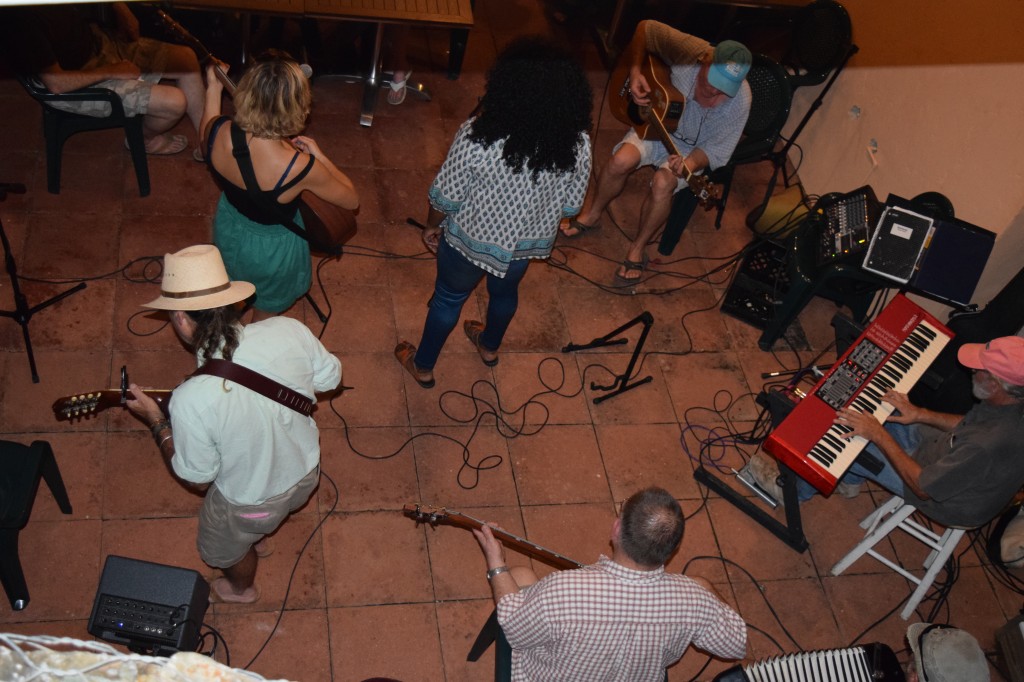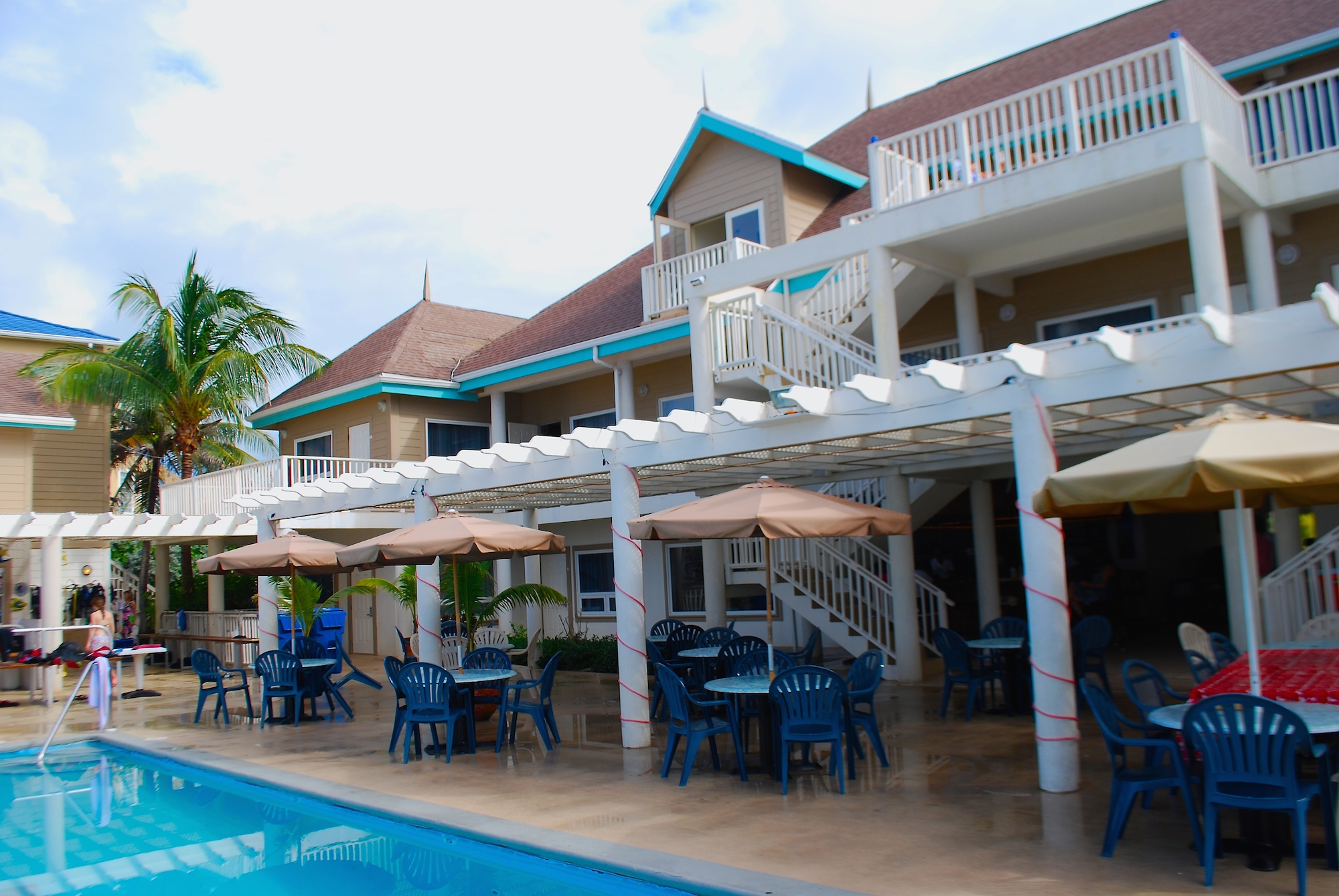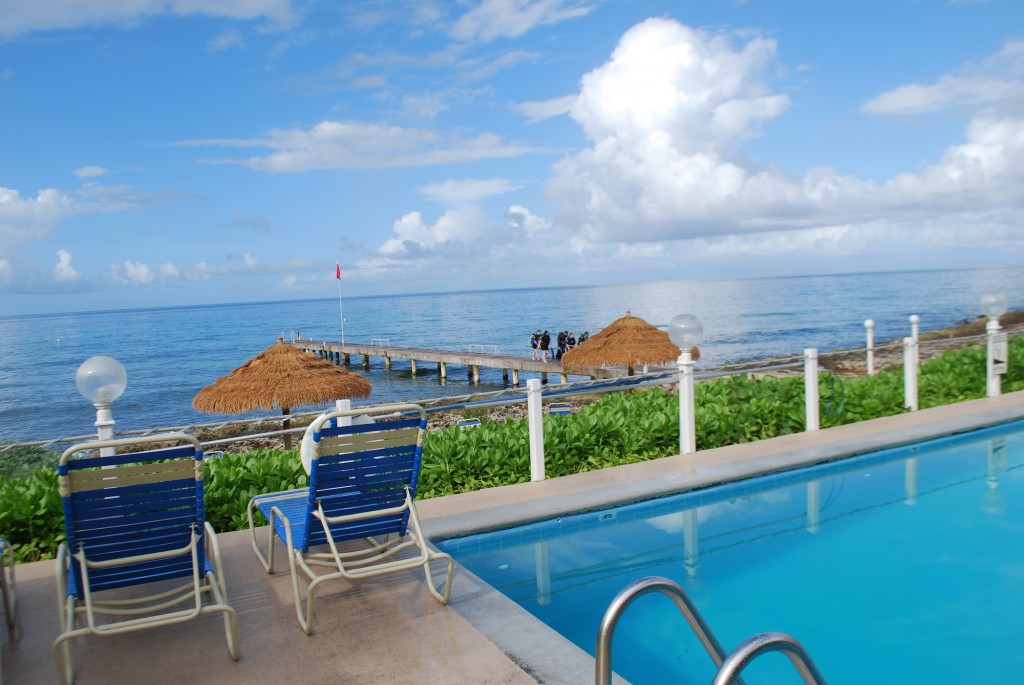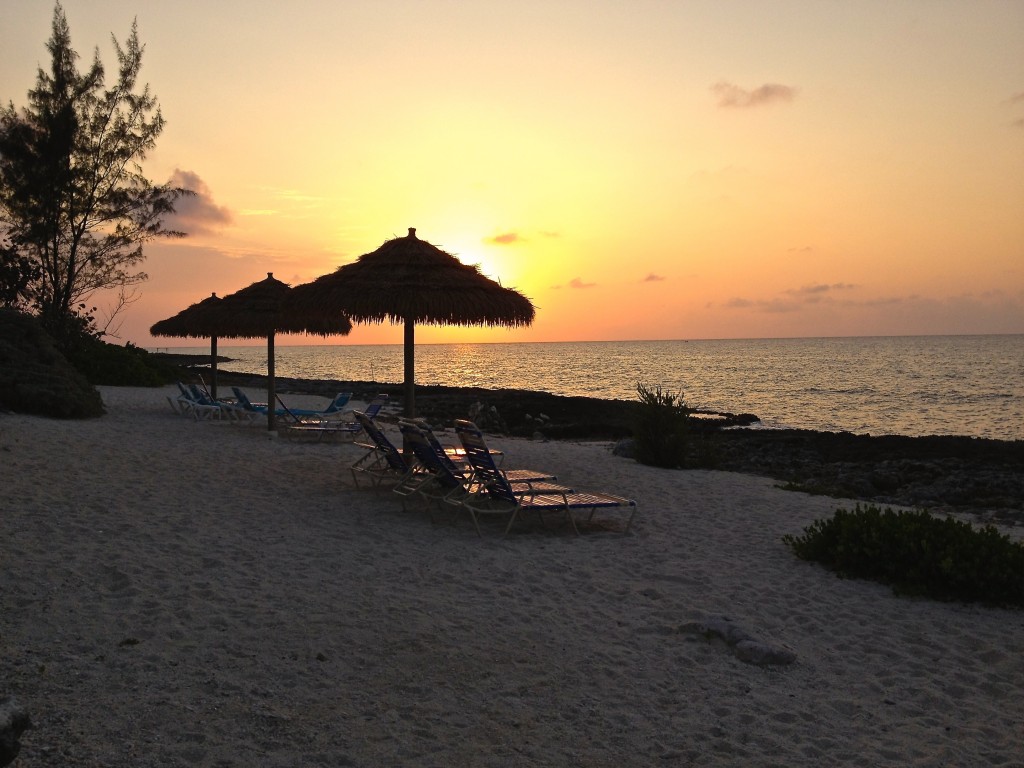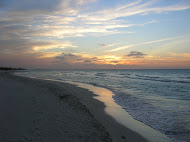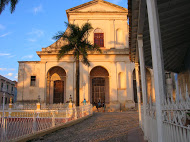A Conversation in Paris with Elizabeth Bourgine
Elizabeth Bourgine talks to Robin Andersen about creating the role of Catherine Bordey on Death in Paradise
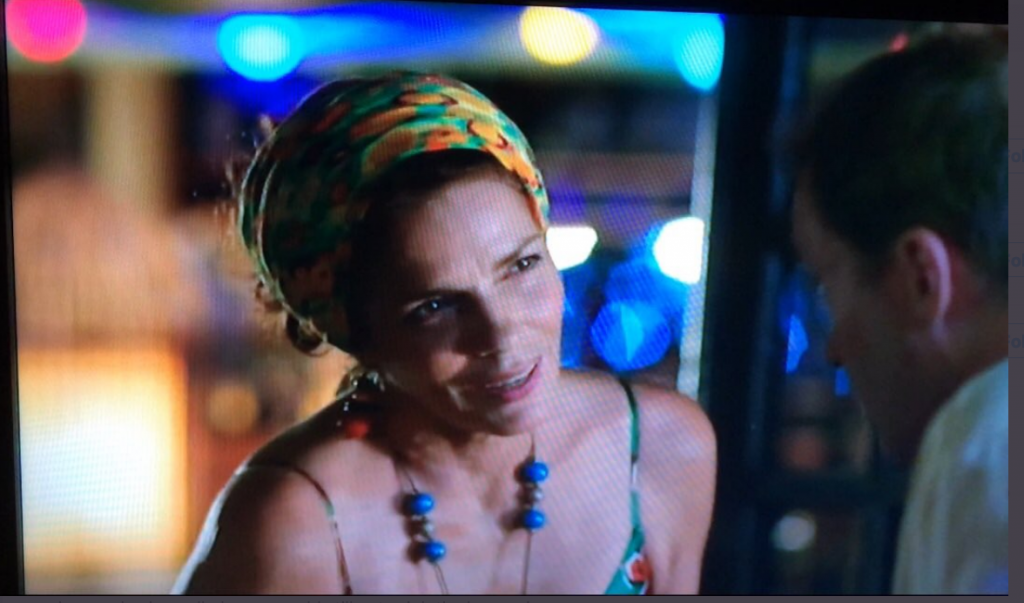
Elizabeth Bourgine walks into Le Select café on the Boulevard du Montparnasse with the same air of confidence and warmth that she brings to her character Catherine Bordey, on the BBC TV series Death in Paradise. I’m already here when I see her walk through the door. She said Le Select, close to where we were staying near the Luxemburg Gardens, was a “typical French café,” so when I saw the long line of broad windows open onto a wide street I was surprised. I had expected something smaller, darker, maybe described as cozy. She greets the shy-looking man at the door, lingering a little as they speak. When she turns to me I cock my head and give a little wave. She’s wearing a knee-length black pencil dress with broad horizontal stripes at the waist, patterned black tights and a leather jacket that broadened her shoulders. Waves of chocolate brown hair touch the top of the jacket. She couldn’t look more different from Catherine, but the way she moves is unmistakable. She occupies the space with her presence like a theater actor does on the stage.
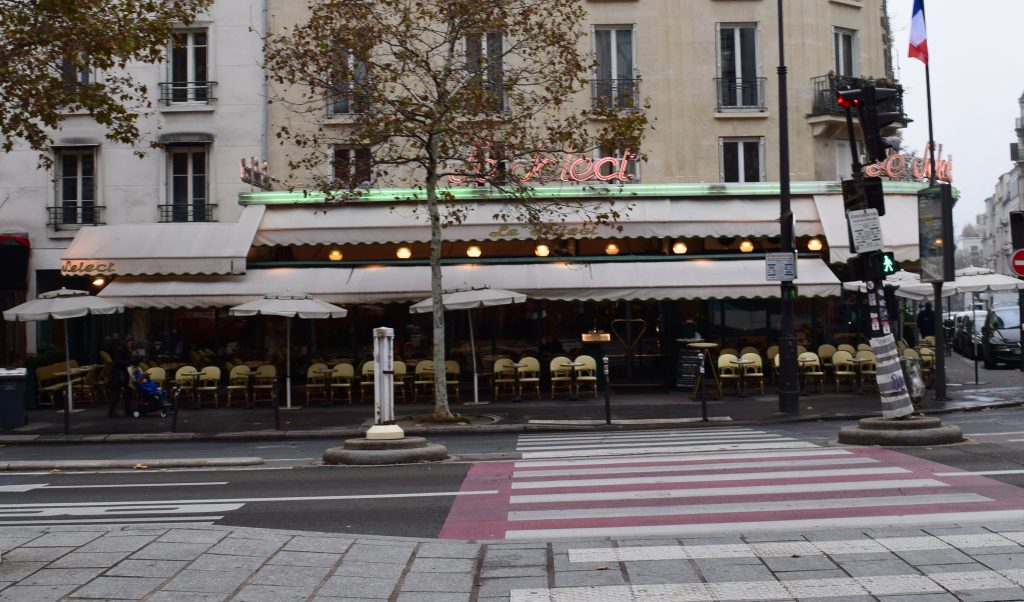
I am sitting at a small round two-top in a surprisingly comfortable French wicker chair. I’d been watching the young tattooed backpackers passing glamorous Parisians on the sidewalk. She gives me the same warm greeting she gave the shy man at the door before she sits down and orders a coffee. It was about 10:30 on a cool Friday morning in Paris when we start talking.
We arrived in Paris the afternoon before aboard the Euro Star—the “chunnel” train that speeds under the English channel from London to Paris. When we started our journey my interview with Elizabeth was not yet finalized, but it didn’t matter. It was Thanksgiving week and we were on an adventure. Neither Guy nor I had been to Paris for more than 20 years, so we visited his mom in Winchester and headed for the City of Light.
We rolled our bags down the uneven path to the Winchester train station as the low winter sun reached out between narrow trees. Arriving at Waterloo station on a fast commuter train, I dashed to a power outlet to text Elizabeth. My message was brief and unassuming; would we still be able to meet this weekend? That done, we climbed into the back of a London taxi for the 20 minute ride to St. Pancras Station, where we were awed by the grandeur of the old sprawling brick building that seemed to go on forever. Newly renovated, the arched colonnades grabbed our attention with bright white syncopated bricks curved over the warm burnt reds of the walls. We hiked around the perimeter until we found the entrance. Once inside we stood still, and gazed up at a huge towering bronze sculpture of a couple, their feet above our heads.
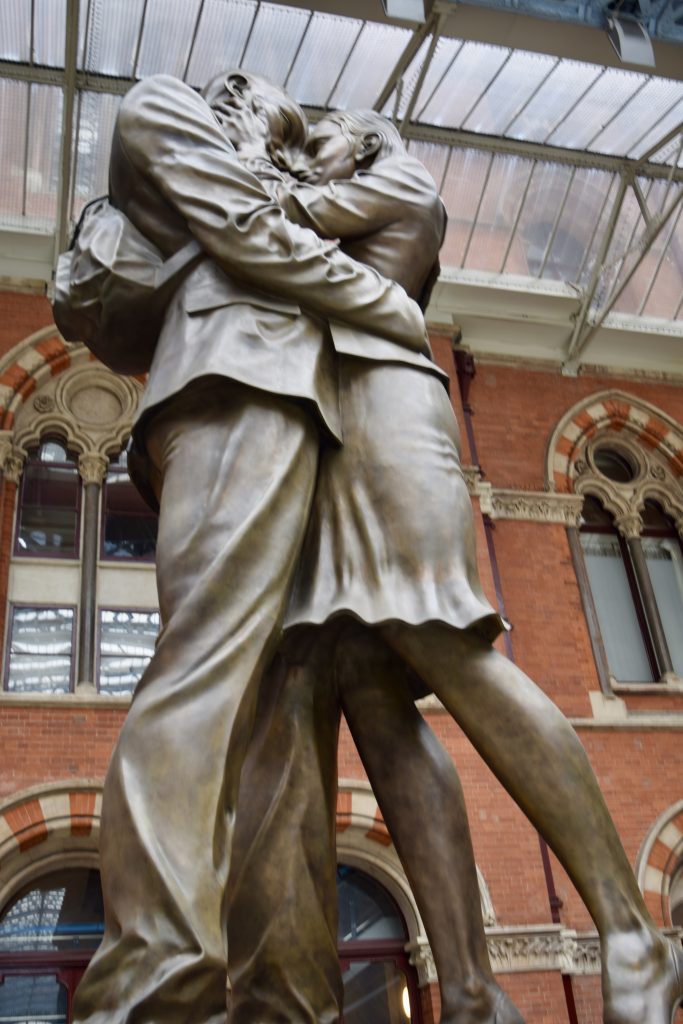
Standing in an intimate embrace, the two seemed to be dancing, but as we circled around them, our heads tilted up in an awkward twist, we saw that they stood still, foreheads touching–her arm wrapped tightly around his shoulder, the other caressing his face. The British sculptor Paul Day, had originally proposed that the couple be kissing. But here they stood amidst the often frantic speed of international train travel, quietly; an aesthetic enigma in a lover’s embrace. “The Meeting Place” is thought to be a self-portrait, depicting Day and his half-French wife, Catherine, and the Anglo-French bond that they embody. We were off to meet another artist who connects the two cultures. Bourgine also creates a French-speaking woman named Catherine, this one for British television. From her terrace-bar-over-the-bay in the fictional town of Honoré, so often featured on Death in Paradise, the character of Catherine helps create the magical mise-en-scene that both British and French viewers love to watch on the mythical island of Saint Marie.
Bourgine is saying, “You know Catherine is a free spirit,” as she holds her head up, straightens her torso and pulls one arm closer to her body. So much of what Bourgine brings to the screen is physical. Catherine moves through the television space, greeting guests and often walking across the road between the bar and the terrace. She commands attention.
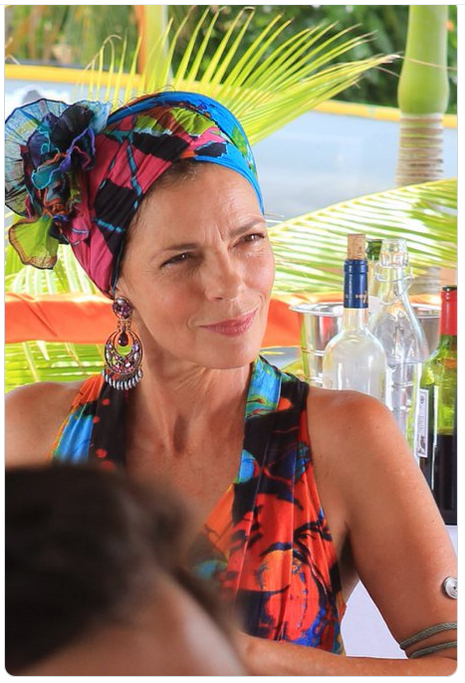
“Catherine is a proud woman, independent and strong. You know she is not just bringing beers,” Elizabeth explains. When she auditioned in late December 2010 for the role of Catherine, she knew they wanted someone over 50, and that was about it, except that she would also be someone’s mother. Then in February in the early hours of a Saturday morning, she answered the phone to hear she had been cast for the part. By Tuesday she was on a plane to Guadeloupe. She read two scripts crossing the Atlantic and found that Catherine also owned a bar. Unlike so much of American television, where main character backgrounds are pretty much drawn out in the program “bible,” Bourgine knew little else about the woman she would play. She would have to build the character little by little. “She’s running a bar you know, so she knows how to be nice to people, but she’s a single woman and still attractive. How many single women of her age do we see?” I give a little nod of appreciation to that insight. “So I thought, I will have to make her a social warrior,” she says with determination. “She’s a mother yes, but she’s still attractive and sexy. She’s unattached and she can be funny. She’s not just a mother.
Arranging this interview with Elizabeth began four months earlier at the end of a long night of shooting on the set of Catherine’s Bar. The location for the bar is the terrace of Le Madras, a café in the village of Deshaies on the French island of Guadeloupe. Filming the end of the last episode of Season 8, Elizabeth walked across the road with a tray of drinks through a warm drizzling rain more times than I could count. I was worn out just watching.
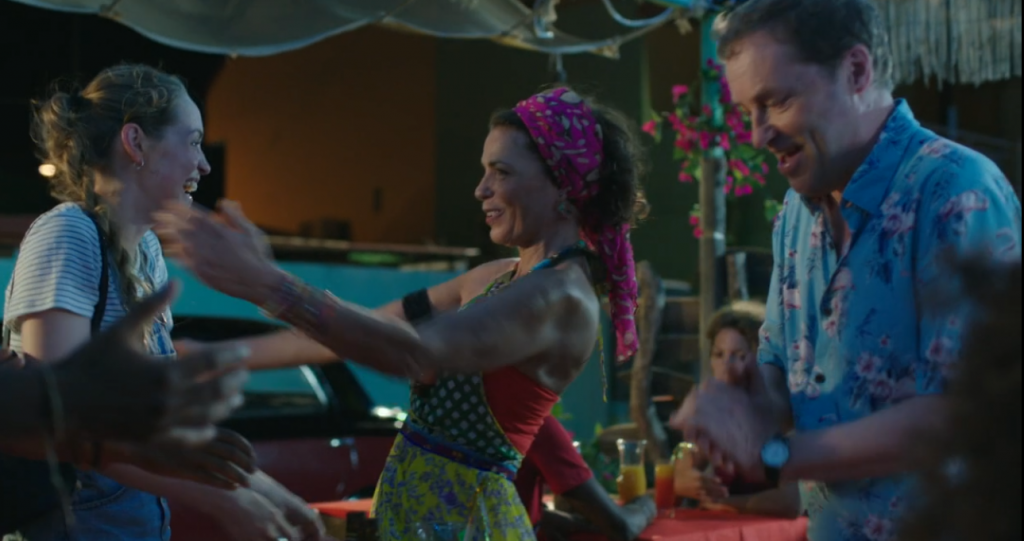
The scene was shot on a rainy night in Deshaies, Guadeloupe
As the crew wrapped up, I went into Le Madras where Elizabeth was gathering her things, and asked, “I know it’s really late and we’re all tired, but could I talk to you sometime in the next few days?” Amazingly, she did not brush me off or get annoyed, which would have been a reasonable response. Instead she said, “I’m sorry, but I’m flying back to Paris in the morning.” I paused only a moment before responding, “I need a really good reason to come to Paris, I haven’t been there for ages. Would that work?” She gave a tentative, but friendly, “Yes, why not?” Delighted, I tell her I’ll message her on Twitter. And so the plan to meet in Paris was drawn with a social media back and forth to determine which dates would work for both of us. When I suggested Thanksgiving weekend, and she said she’d be in town, but we never confirmed which day and time.
Waiting in the downstairs departure lounge at St. Pancras, a state-of-the-art area with warm wooden floors and glass walls, I was taking a last gulp of latte after the speaker announced it was time to board, when my phone pinged at me. As I snuggled into the comfortable seat I thought of the questions I’d ask her. The interview was set; Elizabeth would be available the following morning, and we were to meet at a café close to both of us, and across the street from the American bar, La Coupole, where it is said that in the 1920s, guests were served lamb curry by Indian waiters in full sumptuous costumes. Today it’s more famous for its fancy cocktails.
I am asking Elizabeth about Catherine’s relationship with her daughter, Detective Sargent Camille Bordey, played by Sara Martins on the show. Their interactions cover some of the usual mother-daughter television conventions—Catherine would be happier if Camille were married, for example. Helping her find a marriageable man, Catherine arranges the perennial date, which invariably turns into an awkward affair.
But there are also more challenging issues raised between them. The mother-daughter storyline is a significant thread In Season 3, episode 5, titled Political Suicide, and the issue that it raises stands out for its universal theme and emotional complexity.
The sequences are masterfully acted by Bourgine and Martins, and the other cast members.
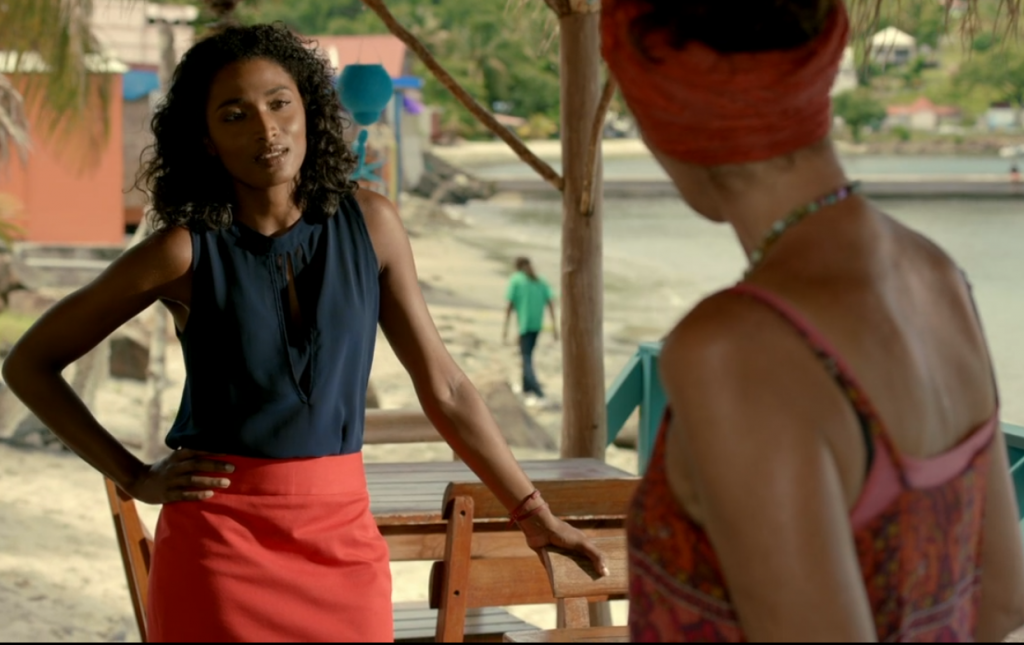
Through the course of an investigation, Camille discovers a mysterious stranger in town who shows up at the scene of a crime. He is a suspect and as it turns out, he is also her father. She hasn’t seen him since she was six. The versatile and intense Clarke Peters—one of David Simon and Eric Overmyer’s favorite actors, best known for his roles as detective Lester Freamon on The Wire, and the proud Big Chief Albert Lambreaux on Treme—is cast as Camille’s father, Marlon Croft. He plays an islander from St Lucia with a relaxed air, though as a negligent father he brings a sense of defensiveness to the role.
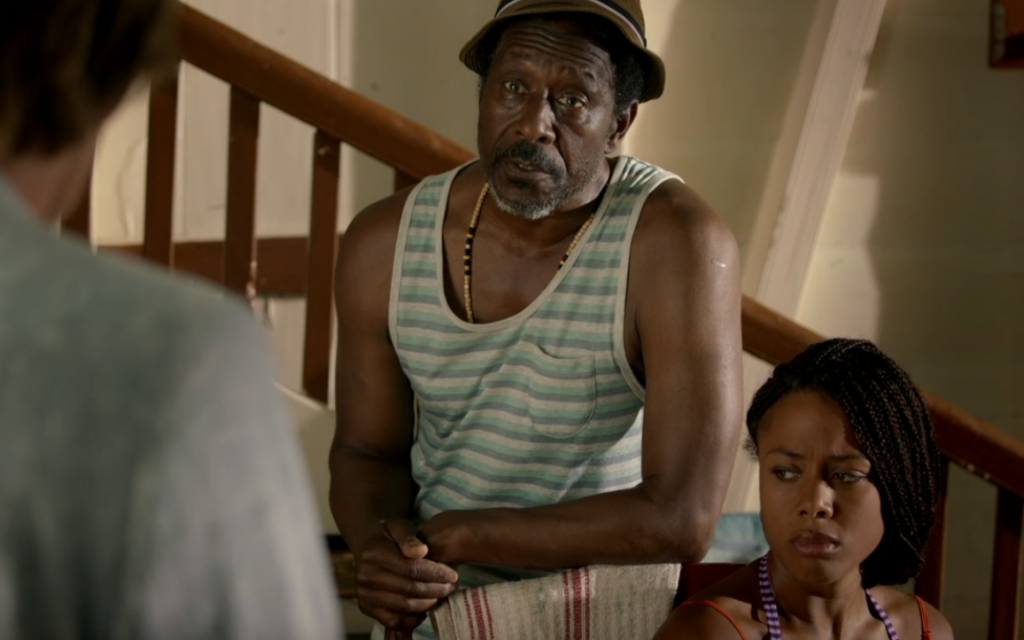
Camille is hostile to Marlon, having always been told by Catherine that he left them when Camille was very young. This is the story everybody has heard from Catherine, as Police Officer Duane Myers (Danny John Jules) explains to D.I. Humphrey Goodman at the station, “He walked out on her and her mother when she was a kid.”
After Marlon is ruled out as a suspect, Camille goes back to confront him. She tells him, “I know what you’re like.”
“You’ve not seen me for 25 years, and you know exactly what I’m like?” he responds.
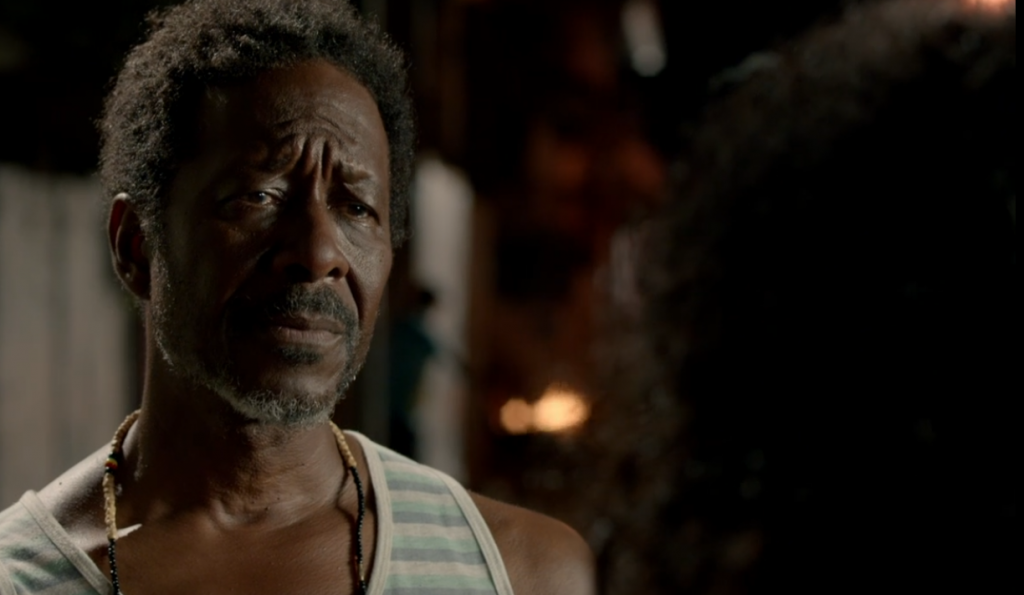
“I’ve heard the stories,” she says.
“From your mother you mean?”
As the scene plays out Marlon tells her, ”Me being out of your life? I was only doing what I was told. What she [Catherine] asked of me.”
Camille is devastated by what Marlon has said. She asks Catherine if it’s true, but leaves little time for her mother to respond. Camille leaves the bar distraught, and Humphrey follows her out. When he catches up to her she tells him, on the verge of tears, “She has lied to me my entire life.”
The resolution to these conflicting stories takes place when Catherine comes to the Police Station. She begins by saying, “I’m just asking for a chance to explain.”
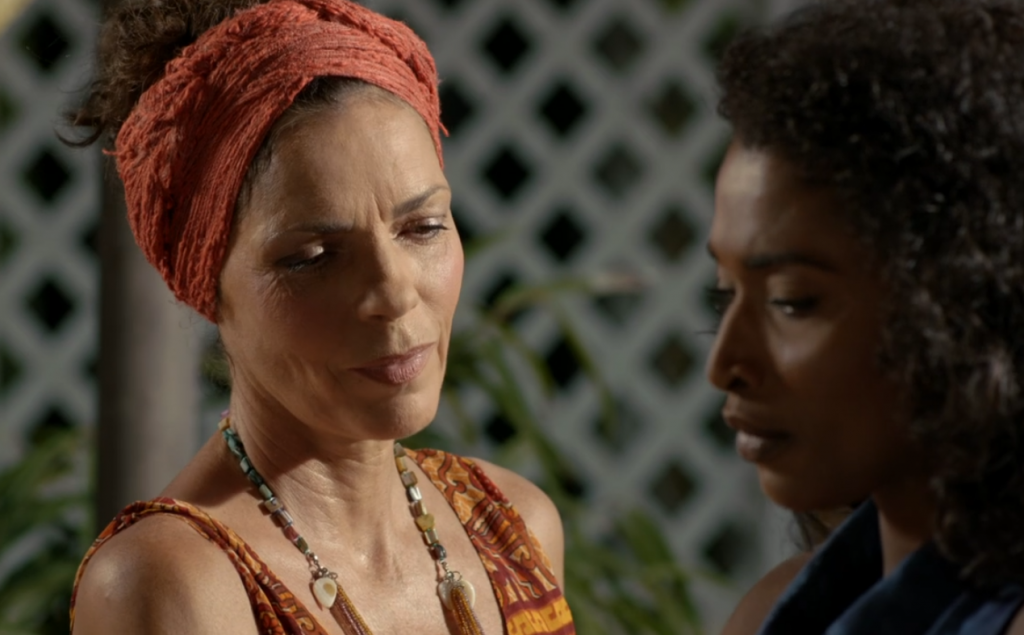
Elizabeth Bourgine plays the scene with quiet but intense emotion. She is at once dignified and vulnerable. But what makes the acting so powerful is the precision she brings to the pacing. She stands in the sun, the camera in sharp focus. Sara Martins, with her back to the sun, takes the more gentle, backlit position. As Camille listens, Catherine tells her what happened when they lived with Marlon on St Lucia.
“One morning he took you to the beach. She pauses and says with a measure of indignation, “By nightfall he still hadn’t come back.“ Then, “I was going frantic!”
“Eventually, I found you, on your own. Marlon was in a bar nearby, playing cards. He has forgotten he had you with him.” Catherine pulls herself up and reveals to Camille, “It was the day I realized he couldn’t be a father to you. So I brought you back home, to Saint Marie. It was what I thought was best for you.”
Later back at the bar, toward the end of the episode, Camille tells Catherine, “And you’ve done the best for me every day of my life.”
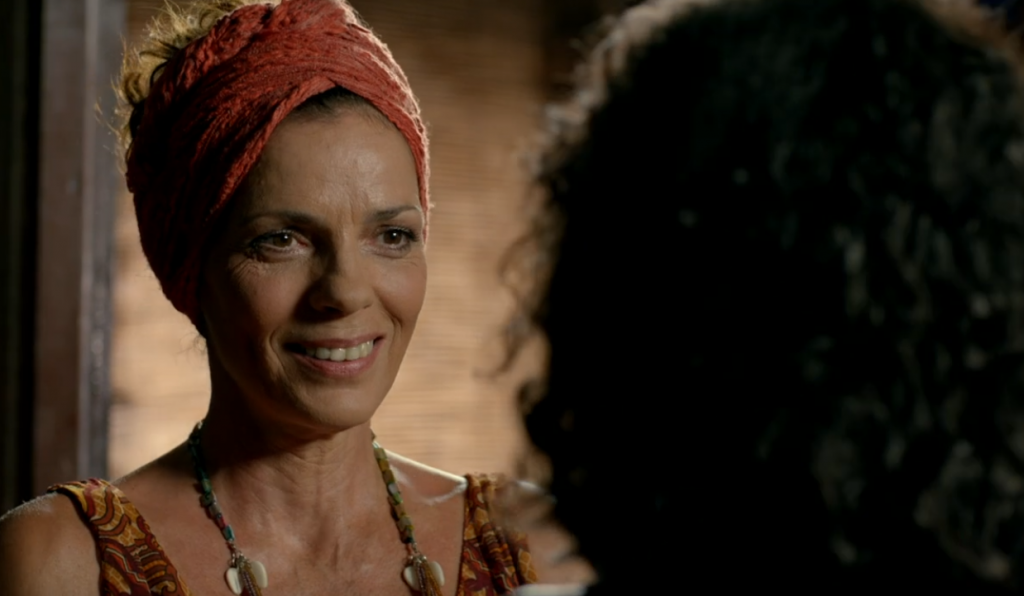
This storyline is well written, acted with eloquence and nicely woven through the episode. As all of the characters interact with Camille, the bonds that tie them are strengthened. It allows Sara Martins to deliver a moving portrayal of personal anguish and resolution. And yet I find myself wanting to see some interaction between Marlon and Catherine. After all, it’s their story too. Years have passed when Catherine’s estranged husband comes back to Saint Marie. How might a meeting between them play out? My dramatic imagination ponders two such formidable actors together on screen. I ask Elizabeth if she met Clarke Peters when he was in Guadeloupe to film the show. She tells me, “No I would have like to meet him.”
Over eight years Elizabeth has been involved in helping create a rare television personality, one among a crowded field of diverse main characters, in a cast also filled with well-known British guest stars on every episode. Probably the greatest challenge came when her fictional daughter left the island. When Camille gets on the boat to take her dream job in Paris, a good portion of Catherine’s identity goes with her. I ask Elizabeth what she thought when Sara left the show. She tells me, “I thought, why keep the mother?” Elizabeth offered the producers an idea. “So now Catherine can be more a part of the social life” of Honoré. “She is without a daughter, why can’t she be the mayor?” Indeed, Catherine does becomes the Mayor of Honoré, a position that sometimes places her more toward the center of storylines, even though the subplots remain outside of the main thread of the crime puzzle, so far.
One of my favorite episode is in Season 7, when Mayor Catherine is coaching Jack Mooney, the third Detective Inspector to appear on the show, helping him write a speech about the commissioner. The enigmatic Commissioner, Selwyn Patterson played with quiet panache by Trinidadian-born British actor Don Warrington, is to be given a significant island prize, and Jack must say something about Selwyn before he receives the award. Much of the episode actually revolves around this story thread, and it includes a sequence where Catherine gives Jack advice about Selwyn’s introduction. She tells Jack, “When I became mayor I was terrified of speaking in public. But I realized there are only two things to remember.”
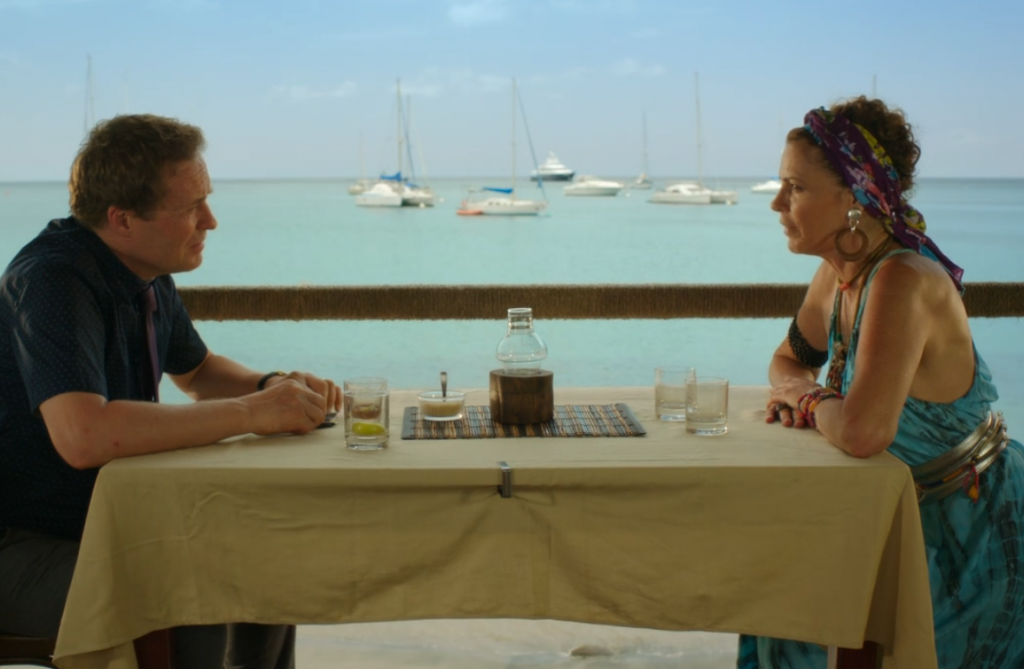
“And what are they?” he asks.
“Keep it short.”
And the second thing?”
“Keep it short”
Jack says flippantly, commissioner, you’re a great fellow here’s your award.
Catherine tilts her head to the left, purses her lips, the corners of her mouth slightly up, flashes her eyes and murmurs, “ Hum-hum.”
Later we are treated to Catherine at a lectern introducing Jack in her official capacity as Mayor.
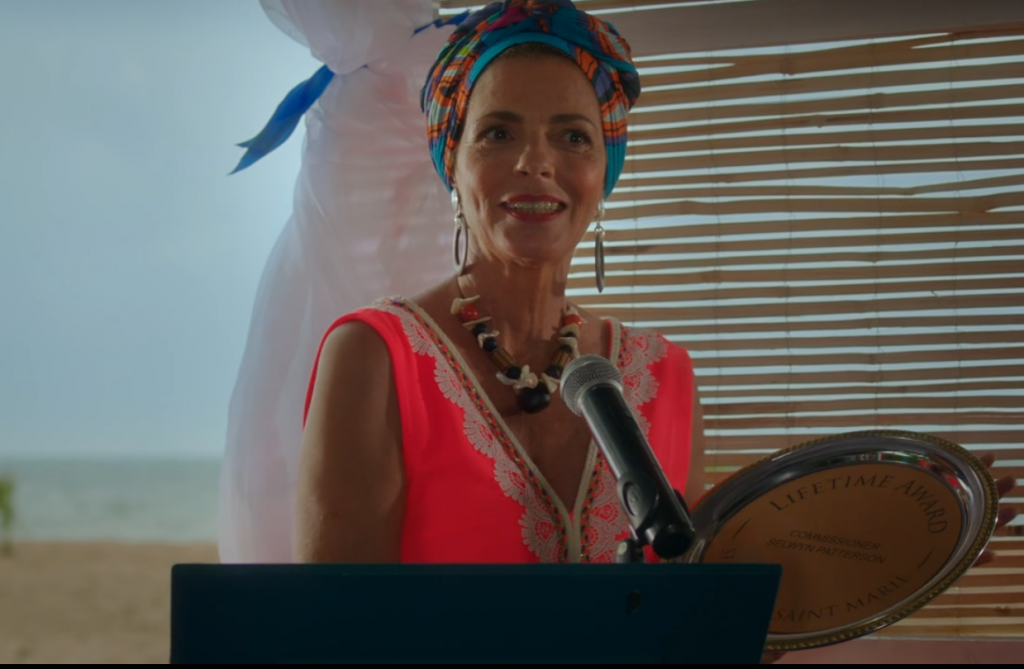
On a program that covers quite a bit ground in a short amount of time, scenes move quickly. Catherine has less airtime than any of the other main characters, forcing Bourgine to make each appearance memorable no matter how brief. She accomplishes this with breathtaking ease.
Catherine’s appearance helps define her character. The costuming helps Bourgine present this rare female TV presence. “I go to London in the spring with the costume designer, and we visit flea markets and consignments stores,” she tells me. On a shoe-string budget, Elizabeth ties the fragments of cloth and adornment she finds in London with things she has acquired in Parise, mixing different colors, elements and styles to create the unique look that Catherine brings to global screens. African scarves are mixed with dresses of compatible print and accented with beads, arm bracelets and dangling earrings. Catherine is portrayed as a Saint Marie native, and with her accent and Mediterranean complexion, together with her style, she represents a multicultural character of imagined descent, adding another layer of global citizenship to the program and its setting.
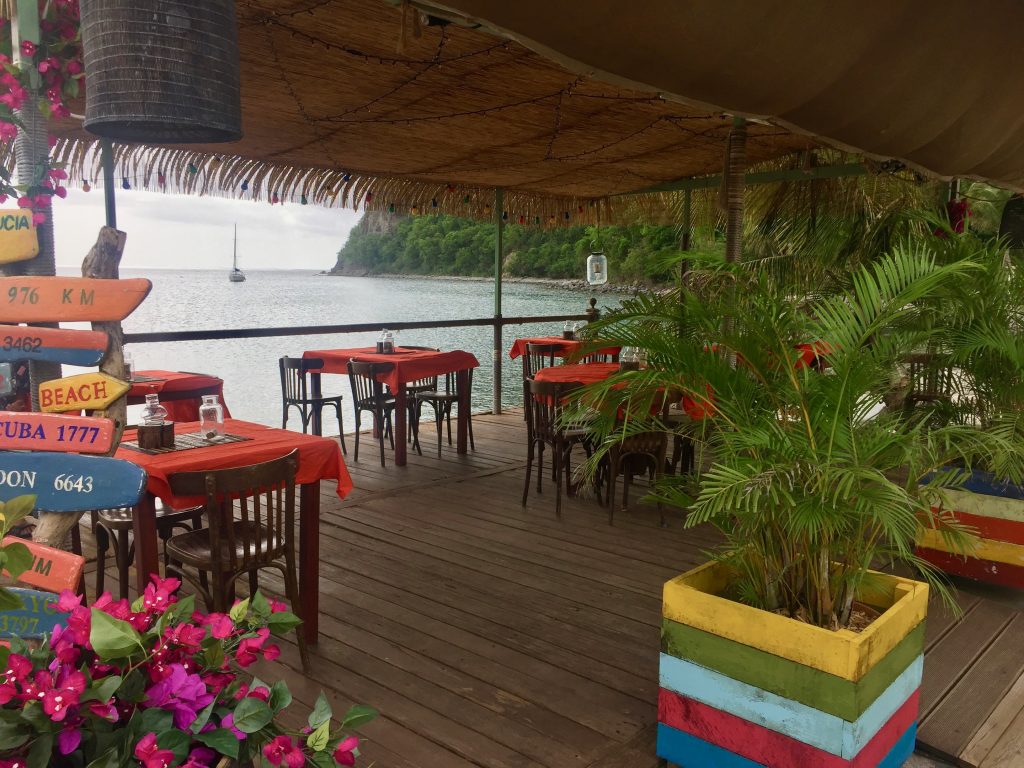
Catherine represents a unique portrayal of a mature, single woman who is confident, attractive and wise, untroubled by her lack of attachment to a man. She is an independent business woman, now a politician, conferring upon her additional attributes that diverge from the usual television tropes that define women “of a certain age.” Her character is a vision of grace and a font of wisdom, and the French actress sitting across from me has had no small part in this creation.
Through the tall windows of Le Select, I see Guy on the sidewalk outside. He’s back from his wanderings through the neighborhood, and I motion to him to come in. We both sit and talk with Elizabeth for another 15 minutes, reluctant to end the conversation. We finally stand and say goodbye with a hand-shake and two kisses in the French style, one on each cheek.
Check in next week for more about the show and the village of Deshaies, Guadeloupe, were Death in Paradise is filmed.
The Best Brew on Guadeloupe
I headed north on the scenic coastal road out of the small bay-side village of Deshaies, and took a right at the round-about at Grande Anze beach, then up the hill to the little brewery called Brasserie Artisanale De Deshaies. In English, it’s the Artisanal Brewery of Deshaies. I arranged my visit with Aline on her Facebook page here
The immensely flavorful beverage springs from a tiny operation. You might call it micro-micro, for the small batches Aline produces out of the well-used cabin perched on the hill. It’s the best beer on the island, and one of the most unique beers anywhere. She likes to change the recipes and try new things. Some of her unique ingredients are hard to get on a small island in the lesser Antilles, like Guadeloupe. Aline mixes different herbs and spices in a secret melange that includes coriander seeds and orange peel, but I can’t tell you their proportions. Other unlikely flavors combine to satisfy the most discerning tastes, such as local coffee beans supplied from a Afro-Caribbean grower who still cares about the island and its history.
It is such a tasty brew, and hard to get. You can buy it at the local “supermarket” in Deshaies called Spar, but it’s best enjoyed at the Paradise Kafe, a colorfully magical bay-side cafe where Aline’s beer is included on the menu.
You can watch a short video of Alien making her beer here.
Finding Paradise
N’allez Pas Trop Vite” Marcel Proust, 1919
I’m sleepy, just waking up, still in bed. Guy has brought me a cup of tea and I’m listening as he tells me about the conversations he’s having with his mom. They’re reading Proust together. He’s trying to help jog her failing memory after surgery. I knew Sonia loved to read the French novelist, if one can call what he writes novels. Just last month, when we stayed in Sonia’s downstairs guestroom in her masterfully fenestrated Georgian house in Winchester, we found three different editions of every volume Proust wrote. At this point Guy is three weeks into their discussions, and of course, we are now talking about Proust.
I have things to do, I have to get up, I have a book to write about my latest project—searching for paradise—but Proust has a tendency to slow everything down. Guy starts reading a passage from “How Proust Can Change Your Life,” a valiant attempt at interpreting the author by Alain de Botton—which proclaims under the title, Not A Novel. De Botton is recounting an exchange between Proust and an American Diplomat in Paris at the end of the Great War. The American, Harold Nicolson, writes in his memoir, “Proust is white, unshaven, grubby, slip-faced,” and goes on to tell of his conversation with him. Nicolson is asked about the peace meetings he’s been attending, telling Proust, “Well, we generally meet at 10:00, there are secretaries behind…” These words elicit from the grubby Frenchman a barrage of complaints and demands for more detail, “Mais non, recommencez. Vous prenez la voiture de la Delegation. Vous descendez au Quai d’Orsay. Vous montez l’escalier. Vous entrez dans la Salle. Et alors? …Mais precisez, mon cher monsieur, n’allez pas trop vite.” Proust’s entreaties are to slow down, take your time, tell me about the car you came in, the stairs you walked up. Don’t go so fast.
As my mind wonders I hear Guy say, “I’ve been finding if you do slow down and start by recalling details, things start to come back to you. I’ve been remembering things about traveling across the Sahara I had forgotten.” Long ago Guy told me about hitchhiking from England to West Africa and back. It was 1974 and he would turn 20 later that year. He still has the old Michelin map of Africa. He pulls it off a cluttered shelf in his office now and then and unfolds it, and one can see the route he took in demarcated jagged lines and circles where he stayed. Over the years I’ve heard only snippets of this adventure. I know he stayed in Nigeria for two months and almost got a job teaching English. On his way back someone stole his boots one night when he was sleeping, even though he buried them in the sand. By then he had run out of money and had only flip-flops to wear as he pushed north through Franco’s Spain during the winter. One of the most surprising things he ever told me was that some years later, he threw away the journal he wrote while he was traveling. “Wait! What!? Why?” I shrieked. To this day he has never come up with an adequate explanation.
Now he starts telling the story.
“I left Algiers and traveled south across the Atlas mountains by bus—at night in a lightning storm. At daybreak we came down from the mountains onto the desert floor, and 200 kilometers or so later we arrived at Ghardaia. I was looking around the town that lay in a depression in the desert.” He gestures by dipping his hand in the air saying. “A soft valley. The houses and buildings were made of mud and everything was a faded white.” He tells me, “I hadn’t been there long when I met 3 young Europeans traveling together.”
Once again my mind wonders, this time to Tony Judt, and his book The Memory Chalet. Judt, the wonderful historian and political essayist, wrote the book in his last days while suffering from ALS. Paralyzed and unable physically to write, we would lay in bed and search through what he called his Memory Chalet. By walking through the doors and entering the ordered rooms of a Swiss Chalet, now in his mind, he would retrieve his early experiences. In the morning Judt would recount the reconstructed memories to the young woman writing them down. I think to myself, Guy’s been searching through his Memory Kasbah.
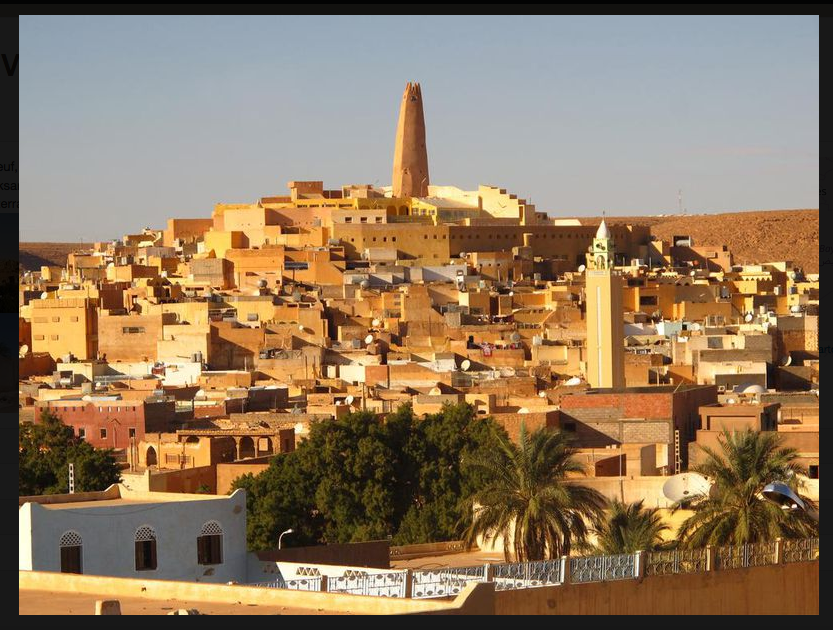 “Who were these people you met there?” I ask him.
“Who were these people you met there?” I ask him.
“They were English and Dutch and had been traveling together for a while,” he says. “They knew each other pretty well. I can’t remember how we met, but we started doing things together. They spoke French pretty well and had gotten to know a merchant in the town who sold local wares, things like baskets and sandals, rugs made of camel hair, and dates, of course. One night the merchant invited us to his home for dinner,” he says, then pauses.
I ask, “What happened?”
Looking thoughtful, he tells me, “We found ourselves in a walled garden where palm trees grew. We ate outside on a low table, and the man brought out platters of couscous and little dishes of dates and nuts. It was the first time I ever ate couscous.” He paused again before saying, “We were in the middle of the desert in the middle of this town sitting in a walled-garden eating couscous under the moon shadows of date palms,” he repeats with amazement. “One of the fellows I was with was so moved, as I was, that he looked around marveling, swept his arm across the setting, and said to our host, ‘C’est un Paradis.’”
As he speaks it strikes me that Guy’s words sound as if they’re coming off the page of a travel journal, a record of his thoughts and impressions. Yet these are the reflections of a different kind of journey, one to the past, to the deep and pleasant moonlit night in a Saharan oasis located now firmly in his memory. Inspired by Proust, he found Paradise hiding there in the past. He walked through the once faded alley ways of his own magical Kasbah, and pieced together the fragments of time. And now he was able to return to that place, as if he had taken a little taste of the madeleine that transported Proust back to the sensations of his childhood home in Combray.
He says, “After stressing out getting through France, Spain, Morocco and northern Algeria, it was suddenly OK to slow down.”
I ask him “Why were you rushing so much?”
“I was reading a lot of Kerouac then, and I must have been influenced by his maniacal intensity to just keep going—It’s all about getting to the next place. He pays no attention to anything on the way.” (Ironically, Kerouac’s main character in On the Road is Sal Paradise.)
“But suddenly none of us were in a hurry anymore. I had enough money at that point to stay there for a few more days, so I did. The people were reserved, but they were gentle and friendly too. I also needed to figure out how to cross the desert. After Ghardaia there was no public transport south through the Sahara.”
Since then Ghardaia, Algeria, the town Simon de Beauvoir once described as a Cubist painting, has been designated a United Nations World Heritage Site. The inhabitants of the city that Guy moved among so many years ago are known as the Mzab people who fled to Ghardaia in the 10th century to escape persecution in the north. He never again saw the three young travelers he met there.
We look up the word Paradise and though it is attributed first to middle French, then lower Latin then to Greek, if you go back far enough you find the word’s origins to be Avestan, one of the two ancient languages of old Iranian, (the language that documents the sacred books of Zoroastrianism). The meaning of Paradise in Persian refers specifically to a walled garden.
Guy says, “I’ll have to tell my mom that Proust is helping me remember things I had forgotten about my trip to Africa.” Guy told me his mom never understood why he decided to hitchhike to Africa, especially since most of his friends were going to India to visit Ashrams and find enlightenment, on a journey his Dad used to call the hash trail to the east. I tell Guy, “You crossed the Sahara and found Paradise instead.”
Hunte’s Garden in Barbados is a World Apart
As soon as you pass through the gates at Hunte’s Garden you are in a magical place where every pathway leads to a surprise—a terrace with seating for two, a spectacular planting of blooms, a laughing Buddha.
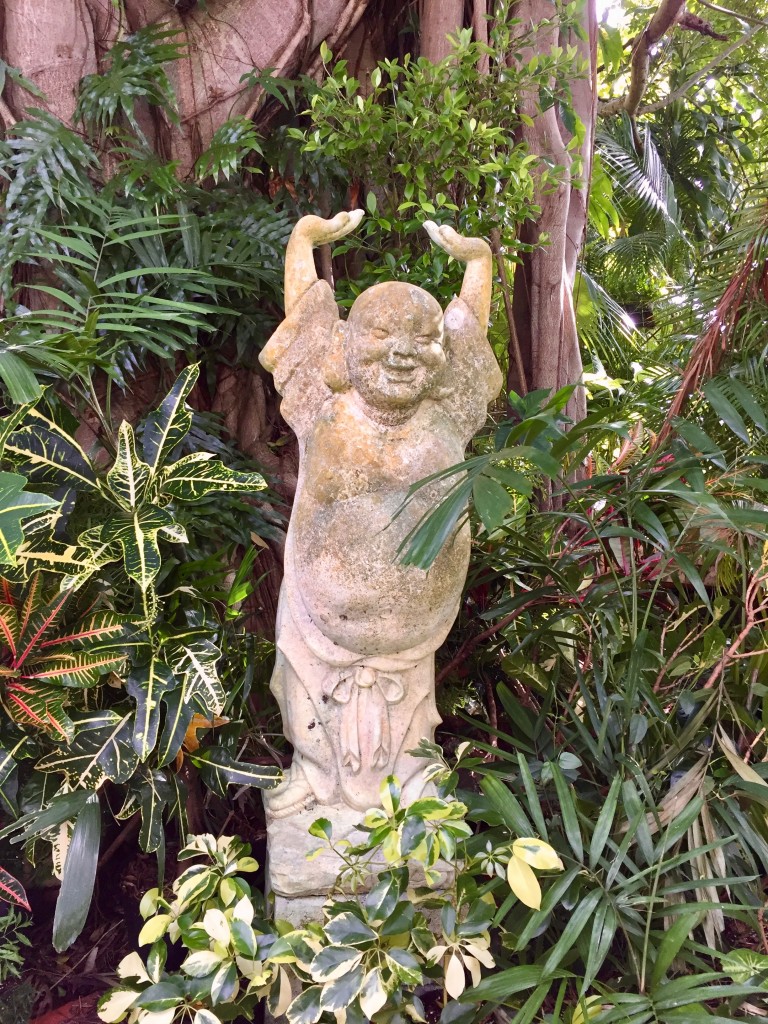 Up the hill from the surf beach aptly named Soup Bowl in Barbados, we almost missed the entrance into Hunte’s Garden on our adventure to meet Anthony and experience the delights of his garden, which he describes as his hobby. Making a sharp right, we braked suddenly at the garden entrance, backed out and parked on the road. We were soon greeted by our host who instructed us to follow the stone pathways down into the sink hole, a huge cave dug in the limestone that once had a roof, but after thousands of years of thinning, finally fell to the ground
Up the hill from the surf beach aptly named Soup Bowl in Barbados, we almost missed the entrance into Hunte’s Garden on our adventure to meet Anthony and experience the delights of his garden, which he describes as his hobby. Making a sharp right, we braked suddenly at the garden entrance, backed out and parked on the road. We were soon greeted by our host who instructed us to follow the stone pathways down into the sink hole, a huge cave dug in the limestone that once had a roof, but after thousands of years of thinning, finally fell to the ground
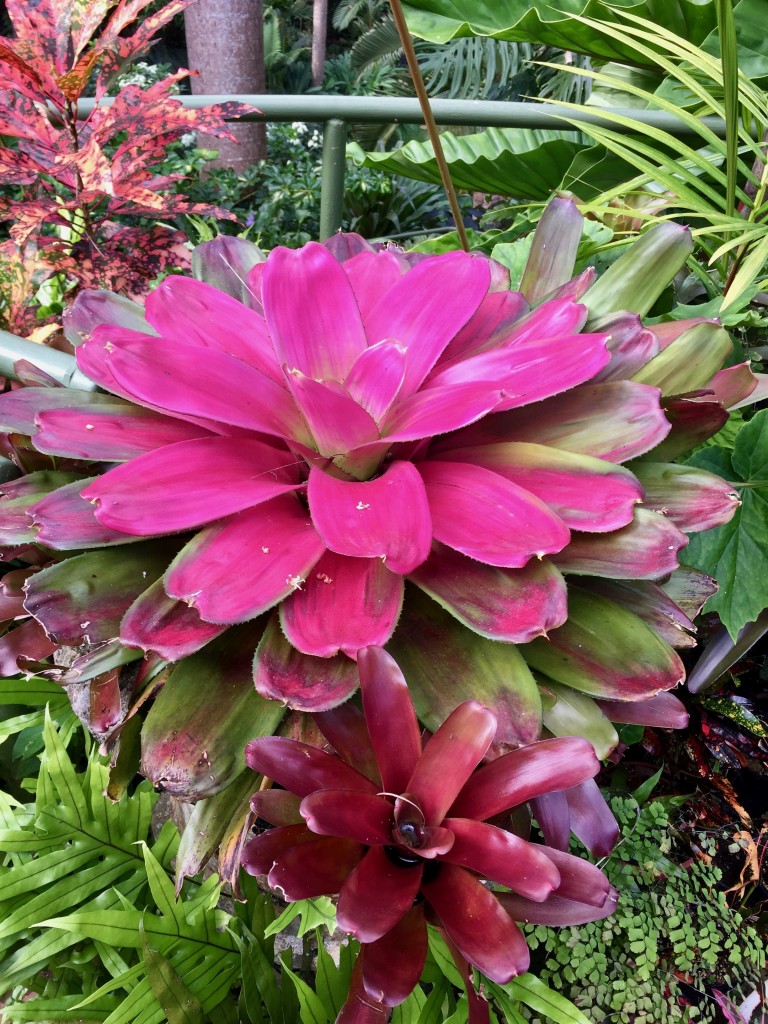 The result is a deep crevasse in the landscape that with Anthony’s touch is transformed into one of the main garden attractions in the West Indies.
The result is a deep crevasse in the landscape that with Anthony’s touch is transformed into one of the main garden attractions in the West Indies.
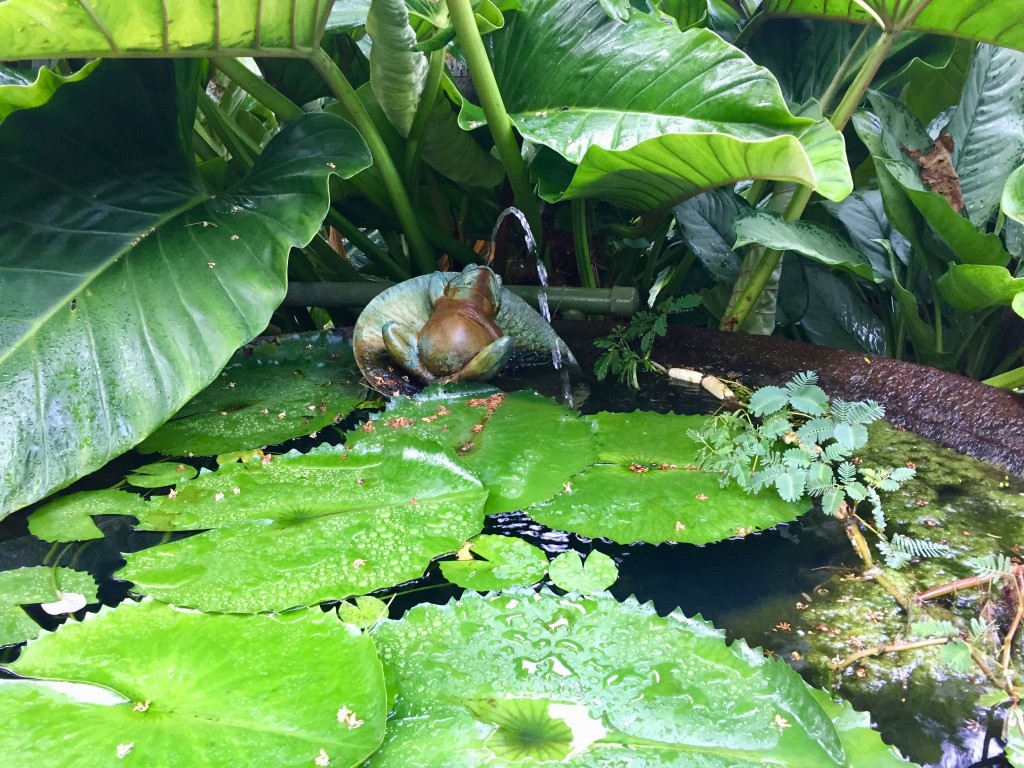 As we followed fanciful footpaths down the green walls meandering through palms, orchids and urns, piano sonatas floated out of hidden speakers created an intoxicating and sensual mix sights and sounds.
As we followed fanciful footpaths down the green walls meandering through palms, orchids and urns, piano sonatas floated out of hidden speakers created an intoxicating and sensual mix sights and sounds.
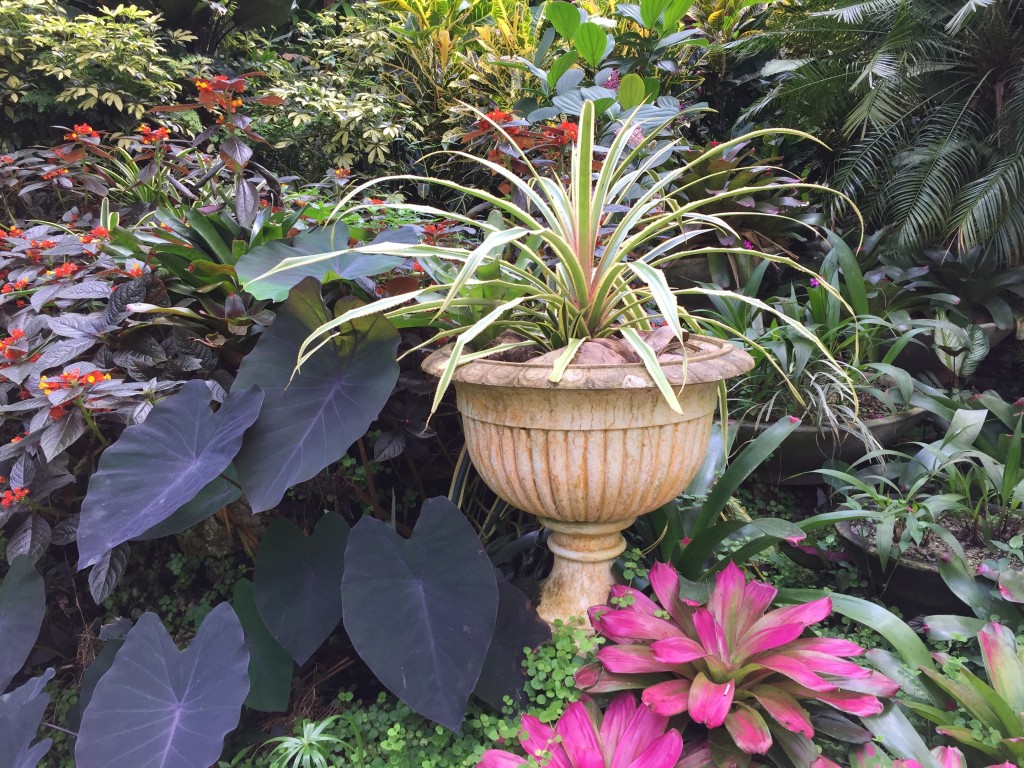 After the botanical delights of the garden we had cocktails with our host who served rum punch and sat with all his guests on a charming balcony covered in plants, pottery and paintings amid the lively chatter of like-minded, international strangers enchanted by Anthony, his stories, garden, hospitality and gentle genus for conversation.
After the botanical delights of the garden we had cocktails with our host who served rum punch and sat with all his guests on a charming balcony covered in plants, pottery and paintings amid the lively chatter of like-minded, international strangers enchanted by Anthony, his stories, garden, hospitality and gentle genus for conversation.
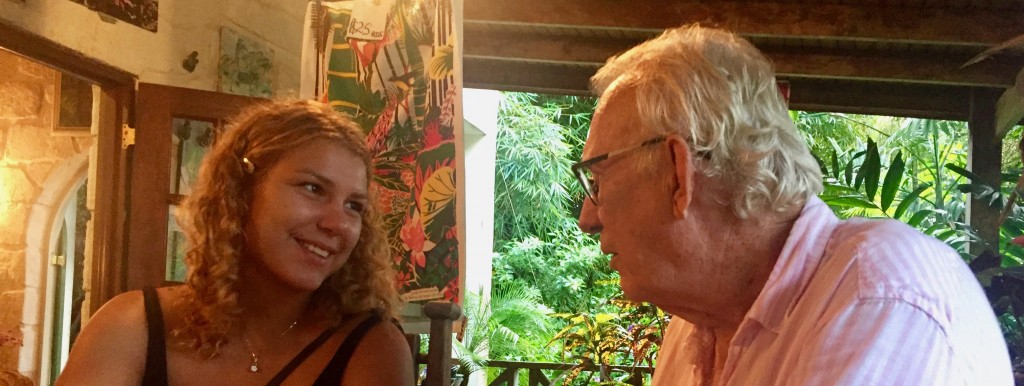
City of Gold: A Food Writer’s Portrait of Los Angeles
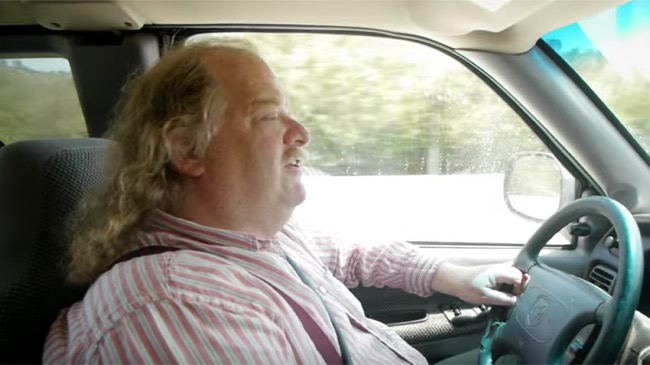 In City of Gold we ride in the cab alongside Jonathan Gold as he cruises LA avenues pointing out small community cafés, strip-mall hideaways and taco trucks. The film is a splash of colorful plates we drink in with our eyes, it’s an audio mix of eighteenth century opera (Gold was trained as a classical cellist) and punk rock, it’s a sidewalk that shimmers in evening light where he parks his truck and climbs out to peer into a food wagon. We see kitchens big and small, some with woks ablaze, others with tattooed chefs serving up lamb bites, and toward the end of the film, even a hot dog off a grill in South LA. We watch him eat, sometimes alone, sometimes in the company of food writers, editors and novelists. We see him from the inside, from the point of view of the cook who takes his order, we see him sit at his dinning room table and watch his fingers meander aimlessly over a computer’s keyboard with an empty screen, we see books piled up on each stair all the way to the second floor of his modest LA home. The film tells the behind-the-scenes story of the cultural food mosaic hidden under LA’s bright sun, of the kitchens where immigrants carry out the full power of their culinary creativity, of the back-story of Jonathan Gold’s food writing as he procrastinates (though he publishes 150,000 words a year) by reading a book or two before he starts. It’s a film whose main purpose is to shine a very bright light on the power of the word.
In City of Gold we ride in the cab alongside Jonathan Gold as he cruises LA avenues pointing out small community cafés, strip-mall hideaways and taco trucks. The film is a splash of colorful plates we drink in with our eyes, it’s an audio mix of eighteenth century opera (Gold was trained as a classical cellist) and punk rock, it’s a sidewalk that shimmers in evening light where he parks his truck and climbs out to peer into a food wagon. We see kitchens big and small, some with woks ablaze, others with tattooed chefs serving up lamb bites, and toward the end of the film, even a hot dog off a grill in South LA. We watch him eat, sometimes alone, sometimes in the company of food writers, editors and novelists. We see him from the inside, from the point of view of the cook who takes his order, we see him sit at his dinning room table and watch his fingers meander aimlessly over a computer’s keyboard with an empty screen, we see books piled up on each stair all the way to the second floor of his modest LA home. The film tells the behind-the-scenes story of the cultural food mosaic hidden under LA’s bright sun, of the kitchens where immigrants carry out the full power of their culinary creativity, of the back-story of Jonathan Gold’s food writing as he procrastinates (though he publishes 150,000 words a year) by reading a book or two before he starts. It’s a film whose main purpose is to shine a very bright light on the power of the word.
His words translate the cultural meanings of food, they map LA neighborhoods and their histories, they describe the dance of diversity that allows readers (and now, viewers) to see LA in an entirely different light, even though this documentary also grounds itself at one point under the huge white Hollywood sign on the hillside. While it illuminates the brilliance that won Gold the first Pulitzer Prize for food writing in 2007, City of Gold captures the tastes of LA so vividly you can almost smell them. It’s a full sensory experience.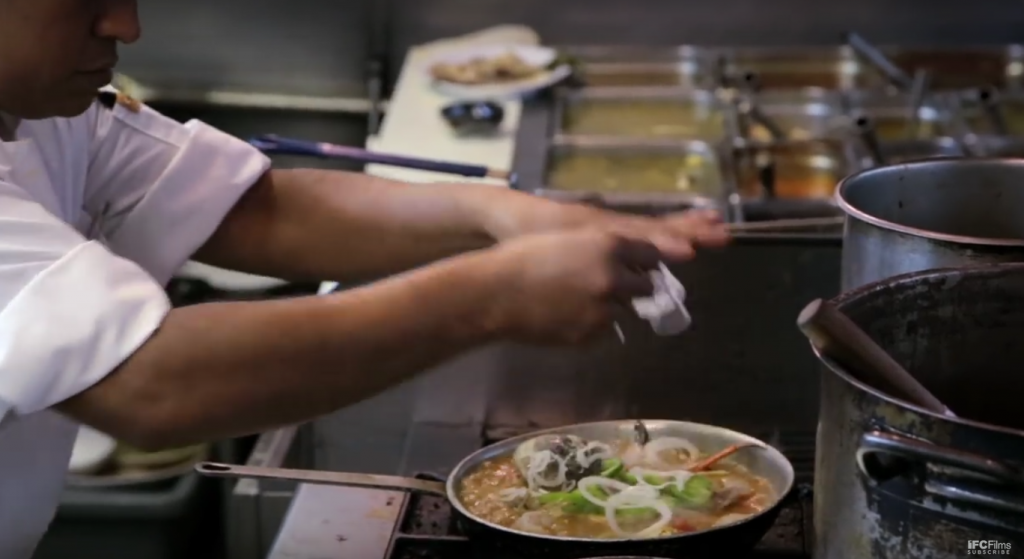
In a film as much about Gold as the LA Food scene, the narratives converge with great uplift at times. A review by Gold can rescue a small eatery from financial disaster, such as the Ethiopian restaurant Meals by Genet whose clientele fell off disastrously after 9/11. One review by Gold and it thrived. (But viewers are left to wonder about negative reviews.)
Gold’s environmentalists brother Mark, finally convinces him to help save endangered sharks. When he does, California passes legislation banning their sale. This is the text shown highlighted on the screen;
But as much as you may love conpoy, dried flotation bladders, crab eggs, braised fish cheeks and the other esoterica of Cantonese seafood cooking, it is hard to work up an appetite for the bitter taste of extinction.
In a year when Hollywood lost itself in glaring whiteness, City of Gold explodes with tastes and color and an unlikely hero who writes it all down.
The New York Times Says St. John is No. 4 on Top Places to Visit: And It’s Better At Concordia Eco-Resort
By the time The Virgin Island’s Daily News carried the front-page story from the New York Times listing Coral Bay in St. John no. 4 on its 52 places to go in 2016, we had already discovered the magic of the place. We were here to get far, far away, and very close to the sounds, smells and feel of a small Caribbean island. So we booked into a cliff-side eco-resort with screened tents, low lights, solar showers and unimpaired ocean vistas.
Getting There
After a flight from New York and a journey across 2 islands, we arrived at Concordia at dinnertime with grumbling stomachs and big appetites. Hot sun and sea breezes hit us on the deck of the ferry from St. Thomas to St. John. From Cruz Bay the open-air, Soca-blasting taxi hugged steep cliffs along the coast road—at times the wide truck body occupying both lanes of the narrow mountain switchbacks. When o ur rolling adventure descended back down to sea level, views of the perfect Coral Bay crescent shimmered in the sunlight. Back up the hill we continued on to the eastern reaches of the island.
ur rolling adventure descended back down to sea level, views of the perfect Coral Bay crescent shimmered in the sunlight. Back up the hill we continued on to the eastern reaches of the island.
After checking in at Concordia and leaving bags in our eco-tent—all the while marveling at the stunning seascapes from seemingly every point on the property—we headed straight for food.
Open Mic Night
By some cosmic good fortune it was Monday night at Cafe Concordia; open mic night—misnamed because the local musician who host the night, John “Johnny B” Bullock and Lauren Magnee, are anything but amateurs. They play here with lots of friends once a week and are so accomplished they effortlessly jam with musical guests visiting the island.
Café Concordia
We settled in at one of the high 2-tops that looked straight into the kitchen and perused menu offerings of appetizers and specialty cocktails, keeping an eye on the chef as happy hour segued into dinner against the rhythms of rock and soul. The chef’s name was Treva, and he moved in the kitchen with unruffled confidence, managing sauté pans on open flames, pulling roasted fare out of the oven, and ladling generous portions of rice from a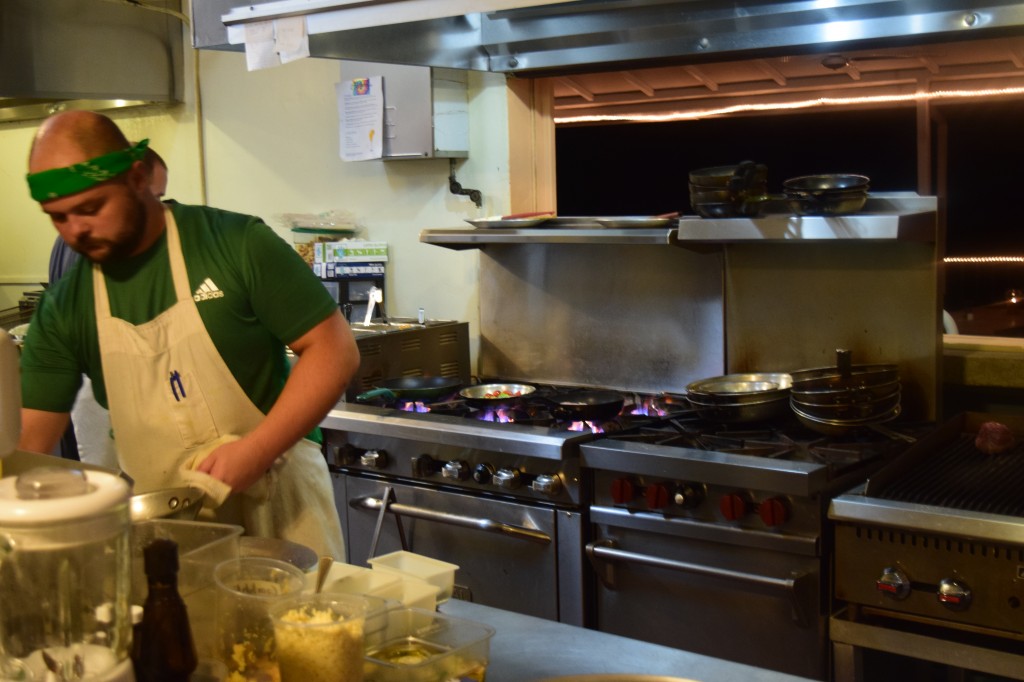 huge pot. The low sun cast long rays of light across Salt Pond Bay, through the dining room, and straight into the kitchen. Treva hit the bell for each dish in sunglasses. Without them the old-fashioned paper tickets would have been back lit and unreadable.
huge pot. The low sun cast long rays of light across Salt Pond Bay, through the dining room, and straight into the kitchen. Treva hit the bell for each dish in sunglasses. Without them the old-fashioned paper tickets would have been back lit and unreadable.
So good was the food and varied the offerings, I was eager to find out more about the café and the people who created this extraordinary delight in a remote corner of the Caribbean. I got a sense of it when Joe Feraco the manager, ended the evening by thanking each of the staff by name. They worked together as a team, that much was clear. And Joe was not a stand-around kind of guy; he bused tables and worked the floor every night we were there, taking a seat only after most of the guests had walked off into the star-filled night.
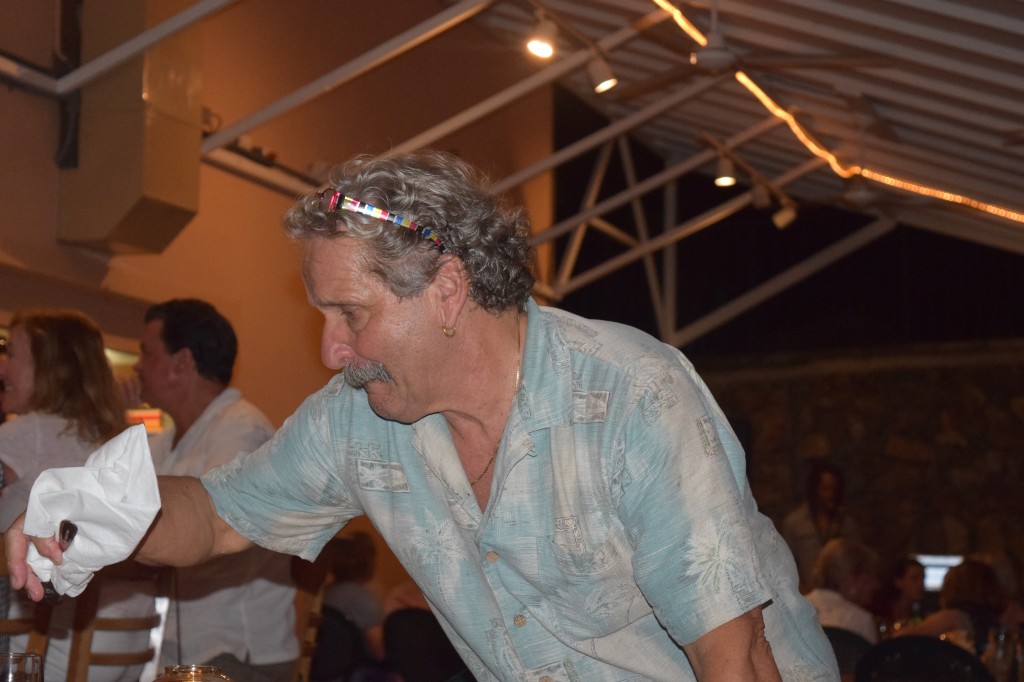
Everything about this place was as surprising and extraordinary as the musicians and the food.
The Chef
When I got a few minutes to chat with Treva, he told me he was cooking for roughnecks on an oil platform in the Gulf of Mexico when he got a call from his friend Kim, who organizes Concordia’s daytime food and beverage. She told him Joe was looking for a new chef.
Treva’s first job in a restaurant was washing dishes. Then he moved on to waiting tables and ended up at Arnauds in NOLA setting Bananas Foster aflame. My guess is he would have stayed in the Crescent City, even with the steep competition for all positions food related, but as he said, “Katrina happened.” Migrating north like so many, he eventually ended up in the kitchen of the Chicago Marriott, where he learned from a talented team how to deliver massive amounts of specialty meals at break-neck speed. There he added sashimi to his growing culinary repertoire.
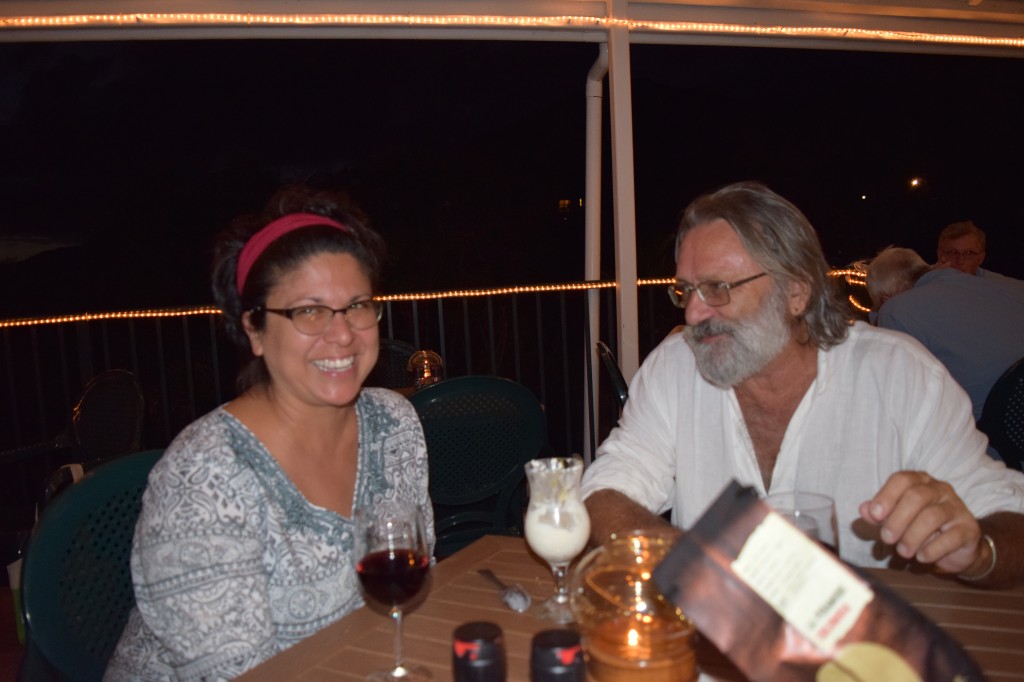
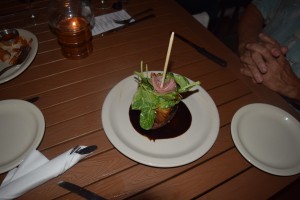
Watching Treva serve up Shrimp Creole, Po’boys, red beans, rice and Andouille sausage, I wondered how such southern classics came to share the menu with Tamarind Chicken Wings, Tempura Coconut Shrimp and Beef Tenderloin Tower with Potato Galette. Treva told me he came from the deep south, a Louisiana parish called Terrebonne – he spelled it for me. Googling it I saw what he meant. It’s a little outpost sitting on the edge of the gulf coast. His time in New Orleans
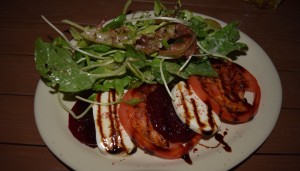
had been a later stop on his culinary journey—the tastes and smells of southern cuisine had left an early craving on his pallet.
There is much more to be said about the character and attitude of this island hideaway. And the rest of Concordia Eco-Resort is as creative, innovative and satisfying as the Café. I’ll tell you about all of it in future posts.
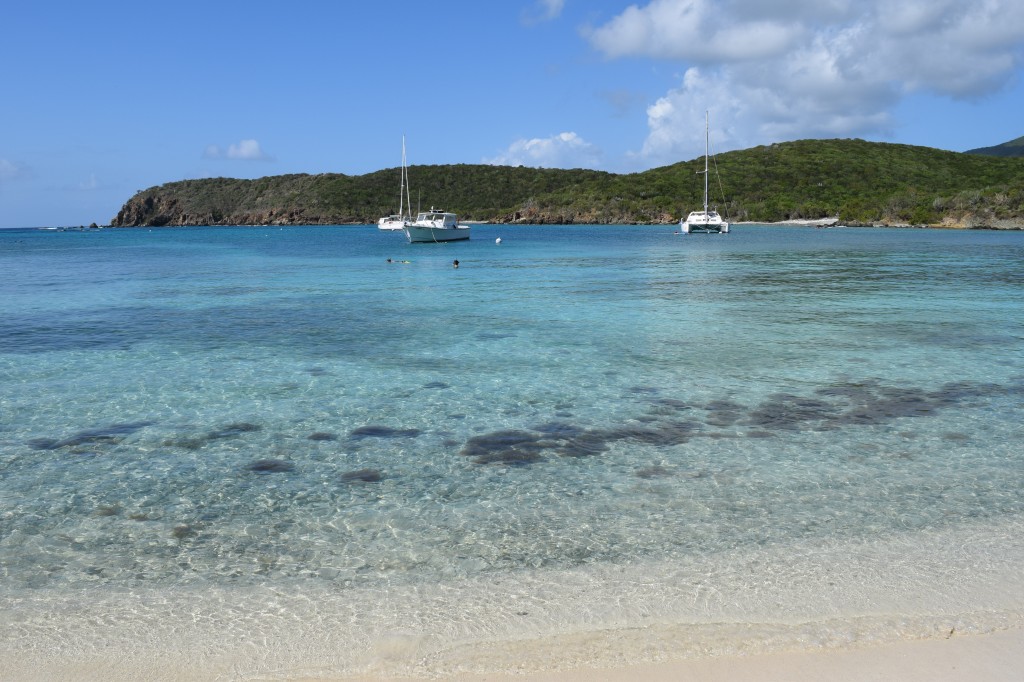
Hiking California’s Anza Borrego Desert in Bloom
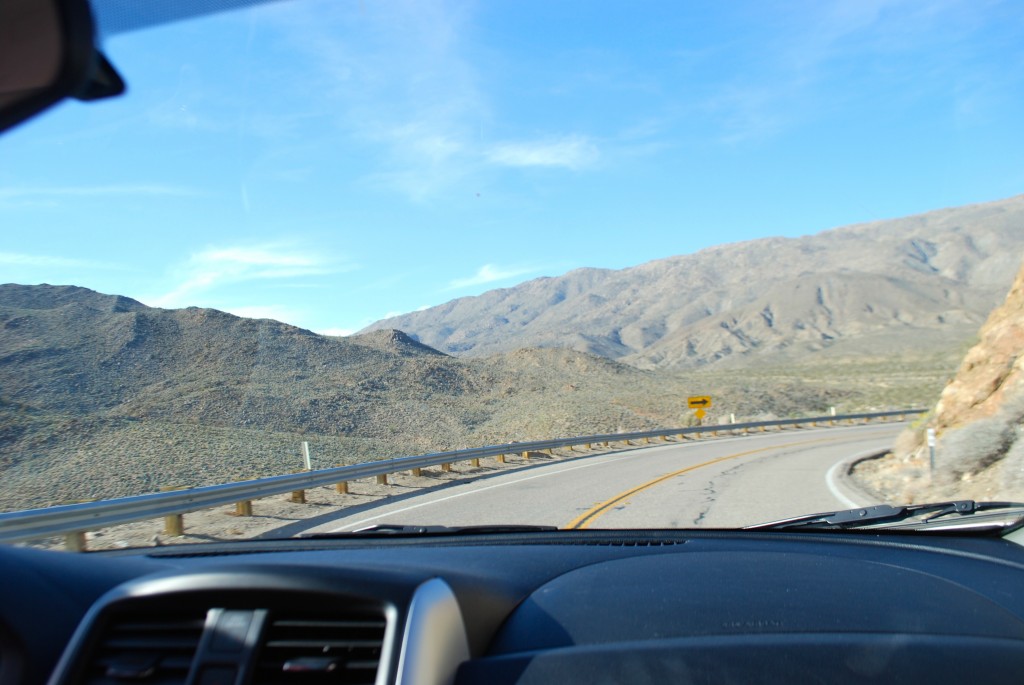 We got our first glimpse of Anza Borrego winding down the steep 7-mile grade of Banner Pass that takes you from the mountains to the desert floor. The blooming desert lilacs shed a light blue hue over the surrounding hillsides as we descended. It was the middle of March, the time when wildflowers create fields of color at the base of the mountains,
We got our first glimpse of Anza Borrego winding down the steep 7-mile grade of Banner Pass that takes you from the mountains to the desert floor. The blooming desert lilacs shed a light blue hue over the surrounding hillsides as we descended. It was the middle of March, the time when wildflowers create fields of color at the base of the mountains, 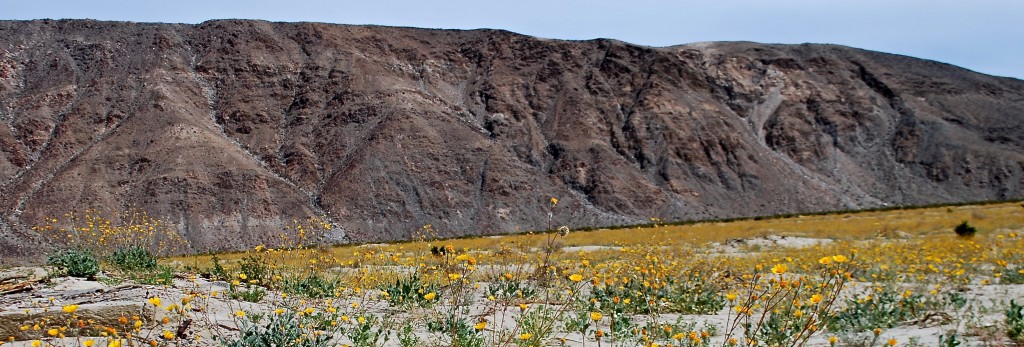 and grab your attention as you hike in the many canyons on a quest to see the desert in bloom.
and grab your attention as you hike in the many canyons on a quest to see the desert in bloom.
Arriving in the late afternoon, we took a swim in the hotel pool and ate an early dinner on the veranda. The fronds on the tops of the tall palms rustled in the breeze that

cools the hot daytime temperatures of the desert. There are few pleasures lovelier than sitting in that breeze with a cold drink at the end of a long, hot, arid day.
When I told my friends we were going to the Anza Borrego Desert for spring break, no one knew where that was. Not surprising for Northeasterners. After all, it lies east of San Diego and is part of the Senora desert ecosystem, all the way across the country and an hour or 2 away from a major airport.
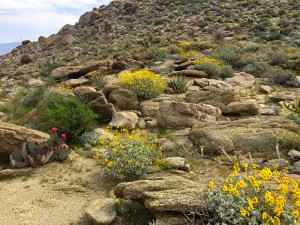
I visited the place a couple times in college and wanted to share it with my partner who was born in Oxford, England and loves the sense of space not possible on a small island; only a large continent offers that. And a desert is full of space—especially this one. It’s big sky country too. Borrego Springs is one of only 9 international “dark sky” communities. The lights are muted and low and the effect is dramatic; at night the sky is alight with constellations.
Hiking on the many trails in this expansive 600,000 acres protected area reveals vast landscapes and stunning vistas. It is the second largest state park in the “lower 48.” (The 6 million arches of “forever wild” forest in Adirondack State Park makes it the largest publically protected area in the contiguous United States.)
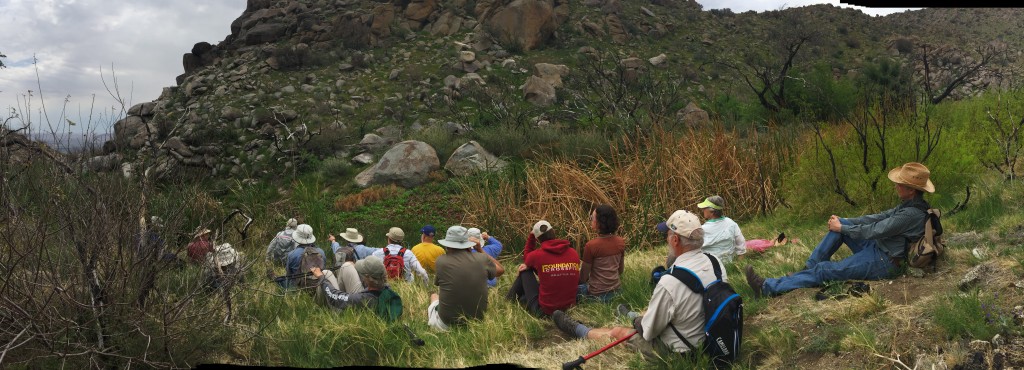
But the experience of Anza Borrego is truly unique; an area called a desert, yet so full of life.
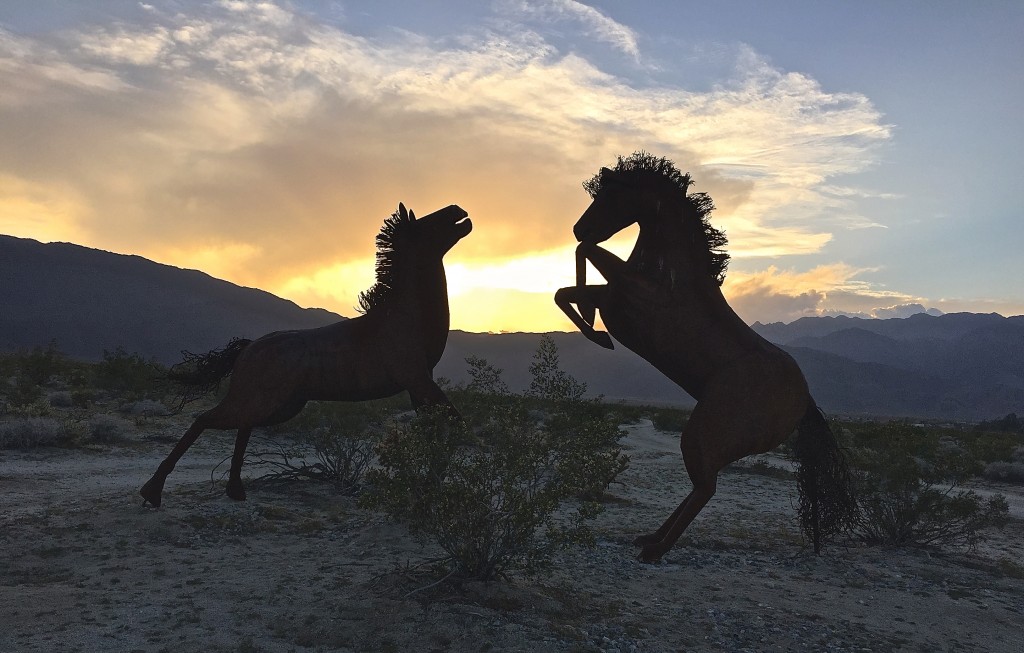
Creating an Eco-lodge for Divers on Grand Cayman: Arie Barendrecht Knows How to Do It.
(author’s note: I covered Cayman for Frommer’s last year and found many wonders that didn’t fit in a guidebook! Here’s one.)
Arie Barendrecht has agreed to talk to me about what it takes to run his popular dive lodge, the Cobalt Coast on Grand Cayman, as a Green Globe certified ecolodge.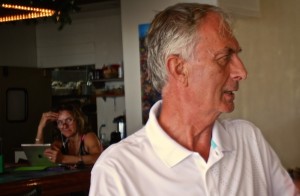
We sit in the shady breezeway of the lodge, perched on the iron shore of West Bay as the sun glistens on the sea. The Dutch-born owner with the piercing blue eyes pats the large three-ringed binder on the table. “This is my green book,” he says. The over-stuffed binder is filled with receipts, documentation, calculations, and all his notes about what he’s done to, what we might call—go green. After all, he’s been on the cutting-edge of earth-friendly initiatives on the island for years. He started recycling, using non-disposables, cutting energy use, and saving water long before others ever uttered the words, sustainable travel.
Cobalt Coast Diver Lodge, Green Globe Certified
We just get chatting and he jumps up to bid a guest a safe trip home and help load luggage into a van. Arie’s really an old fashion hotelier who seems to have a calling for hospitality. But for years he’s also been figuring how to overcome any number of hurdles to make this place green. He’s had to become an expert in what might seem to be mundane trivia like how to combine the best non-phosphate laundry detergent with fabric softner, because he says, “You know conditioners and whiteners don’t mix.” He’s not one to give up easily. He’s found a powered detergent that seems to do the trick. Who would have guessed such little things would make a big impact.
After another break for Arie to greet new guests, he explains the complicated procedures of saving water by recycling and reusing every little drop, even drip water, and using it multiple times. He talks about changing incandescent bulbs at the inn with LEDs. This is not a cheap process; some cost as much as $13 a piece. Nor is he content to stick with the cold-feeling blue-light bulbs, now known to be missing the warm yellows of the light spectrum. The good ones are a bit more expensive, but he found them. On the bright side he says, the new bulbs last longer and he doesn’t have to walk around with the ladder as much as he used to. The light at the Cobalt Inn is warm and saturated, just like the sea and the overall feel of the place.
Changing light bulbs seems like a small step, but together, his small steps constitute a considerable lowering of energy use. Of course he is well aware that the shallow reefs of the Cayman Islands are particularly susceptible to the bleaching that comes with warmer water temperatures cause by climate change.
At times he does get discouraged about the problem of endless waste, but he usually 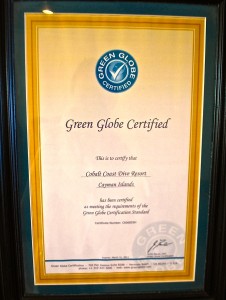 finds a way to deal with it. Take for example paper recycling—there is none on the island, yet. He knows how much ink is in a phonebook and how toxic it can be, so he’s found a repurposing for old books and other paper by taking them to the local animal shelter where they are used again.
finds a way to deal with it. Take for example paper recycling—there is none on the island, yet. He knows how much ink is in a phonebook and how toxic it can be, so he’s found a repurposing for old books and other paper by taking them to the local animal shelter where they are used again.
Recently the government of Grand Cayman recognized his efforts with a Governor’s Conservation Award. He and the staff of the inn sponsored an aluminum can recycling drive at the local Primary School. He describes working with the children and how motivated they get about the work. His example has inspired local gradeschoolers, as the award states, “to become lifelong stewards of the environment.”
I complain that the website doesn’t have any information about the award, and maybe it needs an update. But he’s a graceful European not given to boasting. He’s concerned with other things. Every detail of this cozy, ecoldge has been carefully planned, from the architectural design of the intimate 2-story structure with huge windows, to the imported Finish textiles that decorate the rooms.
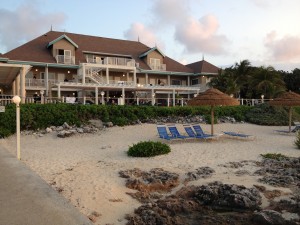 Accommodations such as these with the upscale resort feel attract a wide range of clients and about a third of the guests are non-divers. As a Green Globe certified lodge, it is also a favorite of international travelers of the green persuasion. I grill him on his many names given for the Cobalt Coast—an inn, a hotel an ecolodge, a resort, and tell him in my overconfident way, that he’s diluting his brand. I ask if he’s thought of settling on one description, but he gives me his knowing grin and shrugs. He cares little for such marketing nonsense. He knows what it takes to make it all come together in unconventional ways. After all, if he stuck to conventional ways he never would have tried, or succeeded, in passing the stringent certification standards required by Green Globe, something other have tried and failed to do. Arie wrote the book on green, or at least he put it together in a large green binder.
Accommodations such as these with the upscale resort feel attract a wide range of clients and about a third of the guests are non-divers. As a Green Globe certified lodge, it is also a favorite of international travelers of the green persuasion. I grill him on his many names given for the Cobalt Coast—an inn, a hotel an ecolodge, a resort, and tell him in my overconfident way, that he’s diluting his brand. I ask if he’s thought of settling on one description, but he gives me his knowing grin and shrugs. He cares little for such marketing nonsense. He knows what it takes to make it all come together in unconventional ways. After all, if he stuck to conventional ways he never would have tried, or succeeded, in passing the stringent certification standards required by Green Globe, something other have tried and failed to do. Arie wrote the book on green, or at least he put it together in a large green binder.
Adventures in Cuba: My Last Cab Ride
Standing in the street in front of a line of cabs in old Havana, I tell my Cuban travel minder, “It’s not my fault I missed the bus, it never came to my hotel this morning,” 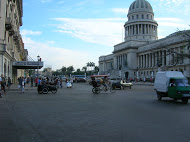 “You have to take a cab now and pay the driver the 20 dollar fare to the airport,” she insists.
“You have to take a cab now and pay the driver the 20 dollar fare to the airport,” she insists.
“But I don’t have the money,” I exclaim.
Through a bit of bad planning and a bunch of plastic cards that are worthless in Cuba, I have only one twenty-dollar bill left in my bag for the airport tax. But it seems I need $40. I can’t quite imagine her letting me miss my plane. Is she really willing to be responsible for a hapless American getting stuck in Cuba? I’m figuring she’s going to relent and get me to the airport somehow. But this friendly negotiation is taking time. She insists that she’s got no available drivers and there is no other way to get there in time.
In the backseat of the cab I see beautiful old Havana speeding past. Leaving Cuba is hard anyway. I’ve explored only a small part of it. Taking a bus on my own down to Trinidad, one the most well preserved colonial towns in the Caribbean, I felt like I time-jumped into the 1930s. The cobblestone streets are faced with huge old wooden doors that open onto secret interior courtyards where families chat in gardens, and in my case greet their guests. After getting off the bus finding which door to knock on was an adventure in itself. I asked a food vendor, the one giving grilled meat to a cowboy who just got off his horse. The grizzled meat vendor directed me up the next street, to the house on the corner of the square. Evenings there emitted an atmosphere of people, stone walkways, smoke, outdoor music, and dancing of course. The steps were classic salsa, but the pace twice as fast as I’d ever tried. Life seemed to have a different pace and purpose here; to take it in through every sense, intensely, relentlessly and doused in a good deal of sweat.
But I didn’t think it would be literally difficult to get off the island. “You can get another foreigner at the airport to give you the twenty dollars for the exit tax,” the driver tells me, expecting me to give him my last $20.
I can’t imagine begging for money at the airport, or anyone actually giving it to me. “I can get the money to you right away,” I promise. “I know people coming down next month on a delegation.” He resists that idea with a skeptical shake of his head. We’re half way to the airport – it’s getting dire.
I study him, wracking my brain. It’s hard to read the face I see in the rear-view mirror with the dark glasses. He’s a think, dark, handsome man. I see he’s wearing a gold neck chain and get an idea. I reach into the back of the car and struggle with my suitcase, turning it so I can reach the zipper. Once open, I dig through it.
“Do you have a girlfriend,” I ask. “No, I have a lot of lady friends,” he says. “Not a favorite one?” I suggest. “Maybe,” he says. “Do you give her presents?” I query tentatively. “No, I don’t need to,” he says. “Well, maybe that’s why you don’t have a girlfriend,” I say boldly. I lean forward and reach my outstretched arm between the seats so he can see my open hand. I ask, “Why don’t you give her a pair of these.”
About 5 pairs of earrings are tangled on my palm. “Choose a pair you think she’ll like,” I say encouragingly. He looks but hesitates. Undaunted, I continue, “Look, here’s a lovely pair of silver ones I got in New Mexico. They’re made by Native Americans.” His head shacks again, more slowly this time.
All at once I realize my mistake, but it’s too late.
At the airport I get out of the cab and he comes around to say goodbye. I thank him, and we smile slowly at each other. Five pairs of earrings makes this an expensive ride, but worth it because I can still pay the airport tax and get back to New York. And he won’t have to choose just one girlfriend now for a while.
